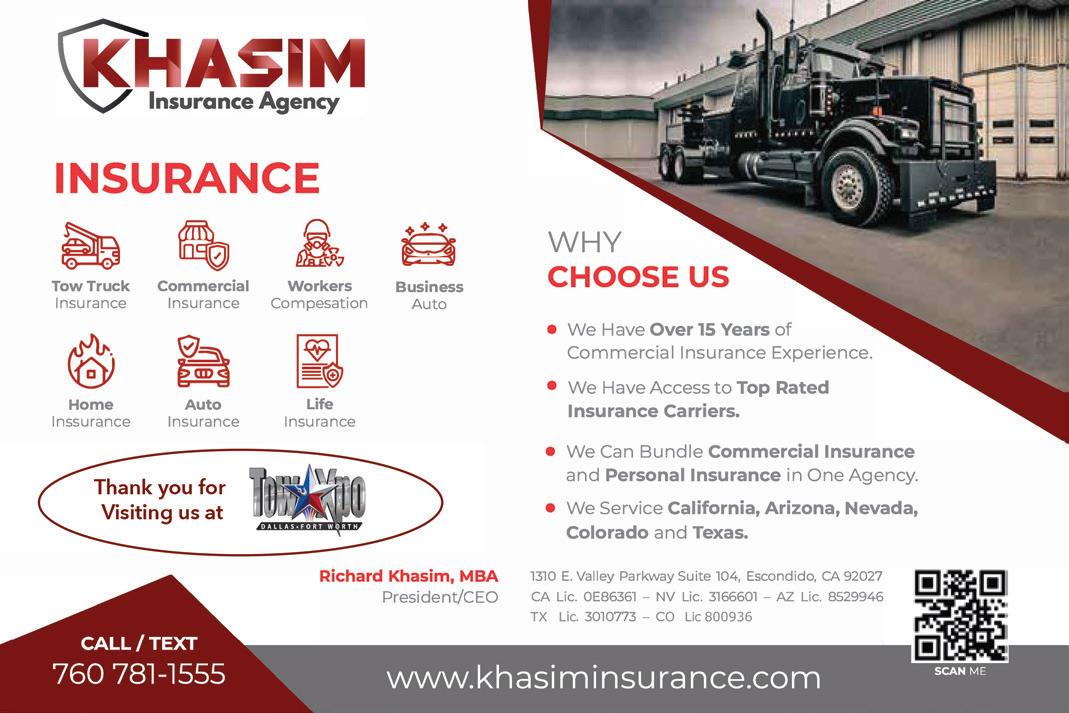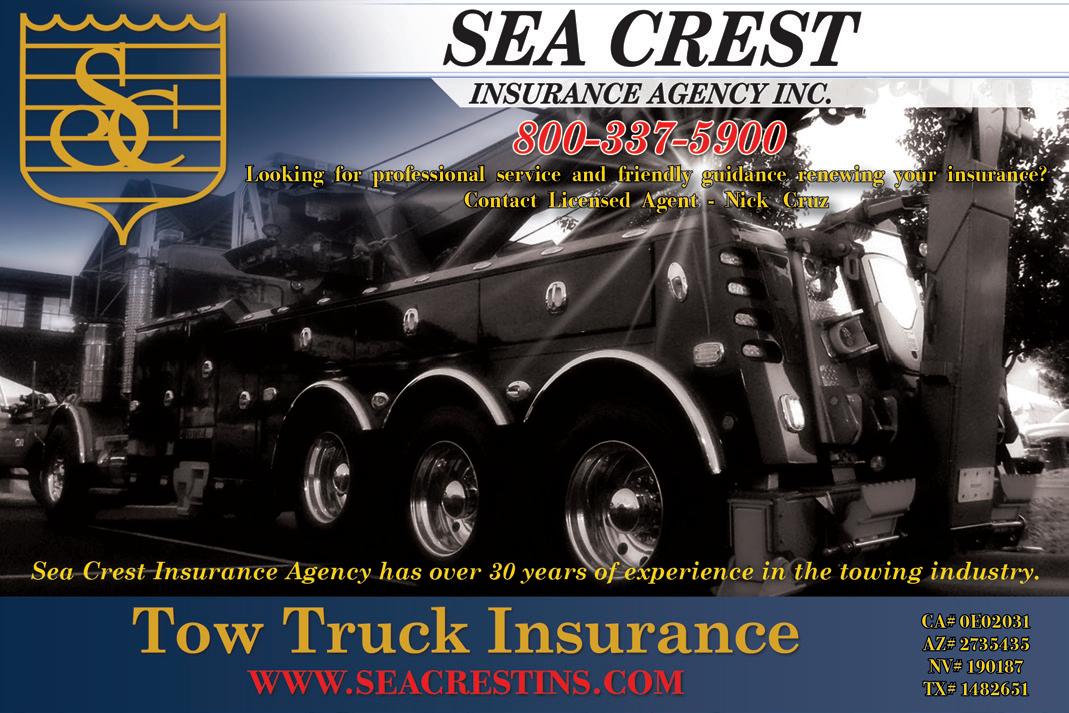






George Nitti














George Nitti







Dennie Ortiz Publisher
Hope everyone is enjoying their Summer—well, as much as those operating a 24/7 business possibly can.
We start this issue with Towing Tech Guru, Terry Abejuela. His article focuses on how to determine the working load limit of the equipment that you mainly use on your rig. Terry emphasizes the critical importance of knowing the equipment rating to ensure both your safety and that of your tow truck.
It can’t be argued that software and mobile phone
technology has greatly helped tow businesses. While Brian Riker reports on the downside of technology use with the disturbing increase in cyber crime, he offers concrete measures you can implement in order to reduce your exposure to this potentially damaging threat.
Keeping security top of mind, Randy Resch digs deep into impound theft and the rights a tow company typically holds and more importantly, what are a company’s liabilities.
“No small feat” aptly describes the featured recovery in this issue. The casualty in this scenario came in with a combined weight of 268,000 pounds! It was handled flawlessly by Tri-State Towing & Recovery out of Indiana, earning them the Donnie Cruse Memorial Recovery Award at the American Towman Exposition last year.
Speaking of the AT Expo, the custom continues this year as we celebrate the show’s 35th anniversary! Tradition abounds in Baltimore as towers gather from all over the world to join together to celebrate this unique industry. Baltimore is truly the Mecca of towing. Throughout the years, hundreds of thousands of towing professionals have made the pilgrimage to the greatest tow show on earth. We have dedicated several pages to the Exposition that will allow you to get a glimpse of what you can expect this coming November.
The Expo is so popular that it’s even become a honeymoon destination. If you want to warm your heart, a sweet story, authored by Stephanie Marchese, recounts one couple’s journey of love that actually culminates at the show!
Thank you for your service.

Steve Temple Editor
Our semi-regular Classic Wrecker series (featuring a 1913 Locomobile with a Holmes 485 twin-boom in this issue) not only provides a fond look back at the early days of tow trucks, but also shows just how far the towing industry has come in the last century. Similar to the marked changes in automotive technology, so too has towing technology evolved to keep up with modern vehicles.
Which begs the question: What does the future hold for tow trucks? While EVs are a growing (albeit problematic)
trend, electric tow trucks just aren’t feasible at this point in time due to a lack of sufficient battery power for the high-load demands of vehicle recoveries. Currently, the only commercially viable electric truck applications are limited to long-haul freight transport and “final mile” delivery vans.
Of course, new technologies are in always in the works, and provide a glimpse into the possible future of the tow truck industry. Internal combustion engines won’t be going away anytime soon, though, as new fuel-agnostic engine platforms for diesel, natural gas, and hydrogen demonstrate real-world potential.
There’s especially a growing interest in hydrogen for use in internal combustion engines, since their emissions are mostly oxygen and water, and new metal alloys can handle their higher combustion temperatures. Also, new, low-energy methods of extracting hydrogen from water indicate there would be, quite literally, an ocean of fuel on tap.
Of course, building a hydrogen infrastructure poses a number of significant challenges, as did the early days of transitioning from steam-powered to petroleum-fueled vehicles. As technology advances, so too, must the towing industry incorporate the changes that are on the horizon.
Copyright ©2024 American Towman Magazine is published 12 times a year by American Towman Media, Inc.
Subscription: Single Copy: $10 1 yr: $60 – 2 yrs: $110 International: $75 & $135


Bill Johnson, TRAA President, and Cynthia Martineau, TRAA Executive Director, along with members of their lobbying team and legal counsel, held the first of multiple meetings directly with the FTC.
During the meeting, TRAA reiterated their policy concerns on the proposed “Junk Fees” Rule which suggests that “predatory towing practices” be added to the final rule. TRAA is against that rule, asserting that Congress already gave statutory authority to DOT and the states to regulate towing, not the FTC.
TRAA continues to deliver this message to various audiences involved in the FTC’s rulemaking, as well as the FTC itself. During the meeting, TRAA also reiterated their policy concerns noted in a February letter to the FMCSA regarding their position against the rule.
TRAA writes in their newsletter: “We have been continually engaging a bipartisan group of Members of Congress on the issue. Towing is a bipartisan issue, and with a Democratic Administration drafting the rule, the optimal way to ensure the best possible outcome for the industry is engaging members of both parties.”
Source: Press Release TRAA
A $75 cap on how much a company can charge for removing a boot from a vehicle will go into effect July 1 in Tennessee. Tennessee Gov. Bill Lee signed House Bill 1731 into law Tuesday that prohibits booting unless an individual is licensed through a local government. To boot a car in a commercial parking lot, a licensed parking attendant must be present, identifiable as an employee, and available to remove the boot within 45 minutes of a driver’s call.
Vehicle owners must be properly notified if their vehicle is being towed, sold, or demolished by a towing company. If the towing process has begun but the vehicle hasn’t left the parking area, the bill requires towing companies to release vehicles to the owner for a fee of no more than $100.
Source: www.thecentersquare.com
The Pennsylvania Legislature passed a bill (House Bill 2251) introduced by state Rep. Ed Neilson to expedite the processing of junk titles for abandoned vehicles, relieving tow truck operators from the burden of storing these vehicles for extended periods.
The bill mandates the Pennsylvania Department of Transportation (PennDOT) to complete administrative steps more quickly, amending Title 75 of the Pennsylvania Consolidated Statutes. It focuses on procedures for abandoned vehicles, including notice requirements to owners and lienholders, authorization for disposal of unclaimed vehicles, and processing nonrepairable or salvage vehicles.
The bill aims to assist tow truck operators by ensuring timely processing and delivery of junk titles, reducing their storage challenges. It also benefits communities by allowing

quicker removal of abandoned vehicles, which improves neighborhood aesthetics and safety. Additionally, the legislation highlights the importance of efficient government processes, demonstrating a commitment to improving PennDOT’s responsiveness. House Bill 2251 passed with overwhelming support (201-1) in the House and now moves to the state Senate for consideration.
Source: www.msn.com
In Chattanooga, where an ordinance regulates what tow companies can charge if they are on police rotation, the same does not apply to companies that are not on that rotation. That issue has become the subject of resident complaints who have come before a wrecker board inquiring about disparate pricing.
“If a tow company is on our ordinance, that regulation absolutely pertains to them. If they’re not on that tow rotation, we don’t have any authority over that,” Sgt. Jason Wood with Chattanooga Police says.
Because of that, there is cap on how much towing companies, like American Tow, which is on the city rotation, can charge. But there is no cap for Chattanooga Impound, which is not on the rotation and tows from private lots like apartment complexes and retail stores, even if Chattanooga Impound subcontracts the work to American Tow.
“I’ve been told by community members and other folks that if Chattanooga Impound is towing a vehicle, American Tow has been used to come get those vehicles,” Sgt. Wood says.
Shannon Yates with Doug Yates

Towing noted that, “I could open up XYZ towing and subcontract to Doug Yates, and I could charge whatever I want based on what y’all are selling me and there’s nothing you can do to me. So that’s what this towing company is doing.”
But Aaron Black with American Tow tells us the two companies are not affiliated. He says they don’t share equipment or lots and he follows the rules.
The Chattanooga Impound Operations Manager Larry Bailey says they set their prices based on time, type of equipment being used, and what they deem to be ethical.
“With the price of diesel and overhead and, you know, a $100,000 Tow Truck and $5,000 a month insurance, it’s a lot of money to run a company like this.
Source: newschannel9.com
Virginia has decided not to adopt California’s stricter Advanced Clean Cars II (ACC II) emissions standards, effective January 1, 2025. This decision, announced by Governor Glenn Youngkin on June 5, means that the state will no longer follow California’s mandate that 35% of new model year 2026 cars be electric vehicles (EVs), with a goal of 100% EVs for new light-duty vehicles by 2035.
Virginia will revert to federal emissions standards under the Clean Air Act after the expiration of California’s ACC I standards at the end of December 2024. Governor Youngkin criticized the California mandates as “unworkable” and “out of touch with reality,” emphasizing the importance of consumer choice in vehicle purchases.
The decision aims to avoid the substantial fines and penalties that could have resulted from non-compliance with ACC II, which Governor Youngkin’s office estimated could have amounted to hundreds of millions of dollars.

Opponents of the California emissions regulations, including state Senator Ryan McDougle, argue that Virginia’s laws should be determined by its own elected officials rather than those in California.
As of 2023, EVs constituted only 9% of vehicle sales in Virginia, highlighting the challenge of meeting the proposed ACC II standards.
By rejecting these mandates, Virginia aims to protect local auto dealers from significant financial burdens and preserve consumer choice in the automotive market.
Source: www.ttnews.com
Washington D.C. will implement a “scofflaw” pilot program focused on towing cars of repeat traffic offenders with thousands of dollars in unpaid tickets, as the city seeks to ameliorate a 16-year high in traffic deaths last year. Drivers with outstanding tickets are deemed riskier and therefore are being targeted.
A pilot program run by the D.C. Department of Public Works, which handles impounding and towing, has the city scouring Ward 1 streets with license plate readers looking for “scofflaw” vehicles—those that have racked up at least $3,000 in unpaid fines.
“The license plate readers are able to read the license plate as the enforcement officer is going by and that tells them the person’s status,” said Charlie Willson, director of D.C.’s Vision Zero program. “So based on that, they are traveling with a tow truck that can then immediately tow that vehicle.”
Willson said it’s in the name of

A pilot program will tow vehicles in select parts of Washington, D.C. for excessive parking violations.
safety, not money.
“What we know about our folks who have more violations and outstanding fines is that it correlates with risky driving,” Willson said. “The goal is to get the risky drivers off the roadway.”
The District has also beefed-up other efforts to collect unpaid fines by expanding the number of teams that can boot a vehicle from two to 10.
Source: axios.com and wtop.com
The National Open Commerce and Safer Highways Coalition (NOCSHC) sent a detailed letter to the FTC expressing their concerns over a proposed rule regulating unfair and deceptive fees which they believe conflicts with existing state and local regulations, particularly towing, initiated by law enforcement. The coalition maintains that the rule could impose impractical requirements, such as upfront fee disclosures, which are not feasible in emergency towing situations where costs are variable and unpredictable.
In the letter, NOCSHC highlights that these concerns were not adequately addressed during the rulemaking process due to limited opportunity for industry feedback. NOCSHC argues that Congress has exempted certain towing operations, including law enforcementinitiated towing, from federal preemption, indicating that such matters should be regulated at the state and local level.
The coalition urges the FTC to consider these exemptions and avoid imposing federal regulations that could disrupt local practices and agreements. NOCSHC requests an opportunity to discuss these issues further with the FTC to ensure that any final rule does not negatively impact law enforcementinitiated towing operations and adheres to the existing regulatory framework.
Colorado Gov. Jared Polis signed into law Bill HB24-1051 which prohibits towers from patrolling private lots and looking for infractions. The law also forbids property owners from using third-party companies to authorize their tows.
The bill was in response to numerous complaints about tow operator Wyatts Towing from lawmakers, consumer advocates and the Colorado attorney general, accusing the towing giant of skirting state statute.
The legislation would make it illegal for tow companies to authorize tows from private lots but mandate property owners, or their employees, to authorize tows. Pre-authorization or automated emails would not be allowed.
Source: www.denverpost.com
A new safety vest for people who work at roadsides or in darker areas is now being sold by Rage L.E.D. This company was started by three firefighters who wanted to provide better illumination for worker safety. The lights on this vest flash so a tow operator is more visible against both the dark or the lighting on working trucks and vehicles. The vest’s lights and flashing patterns can be easily changed by the wearer and the lights are recharged using a micro-USB port (instead of AA batteries). The Rage L.E.D. vest is made in-house, by hand at U.S. facilities on the central Oregon coast.

Warn Industries’ next winch for trucks and SUVs is the all-new ZEON XD. Drawing from over a decade of experience with its previous ZEON winch, Warn added significant enhancements in creating the ZEON XD. Designed, engineered, tested, and assembled in Clackamas, Oregon, the ZEON XD features a new high-performance, high-efficiency electric motor and threestage planetary gear train. This powerful combination delivers line speeds of up to 40 ft/min. Plus, OEM-grade bus bars provide efficient electrical connections, removing exposed, inefficient wires. The result is a winch that pulls harder and faster for longer periods of time in the harshest conditions. Full-metal armor and O-ring seals protect ZEON XD from moisture, trail hazards, and damage. Also included is Warn’s strong, lightweight, and easy-to-handle Spydura synthetic rope.
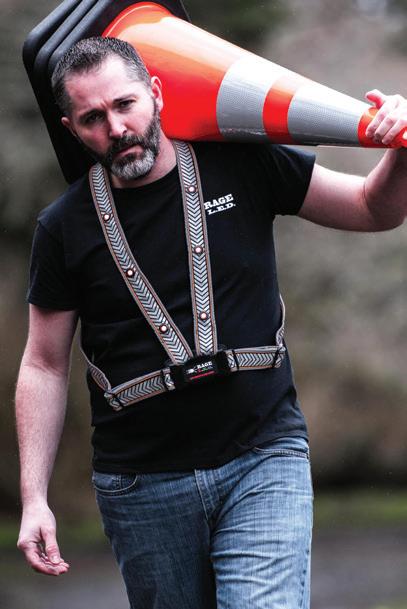
The Zip’s Side Puller Recovery Tool allows your car carrier to remain parallel with the road. This unit can be easily fitted into position utilizing the standard key slot holes along the rear approach plate on all Miller Industries 10, 12 and 16 Series steel car carriers (aluminum decks require drilling a mounting hole). It is secured in place with a hitch-pin and hairpin cotter pin. The operator simply utilizes the carrier’s existing winch and winch line, feeding the line through the guide and onto the 3-roller guide system. The rated weight capacity is 9,000 pounds.
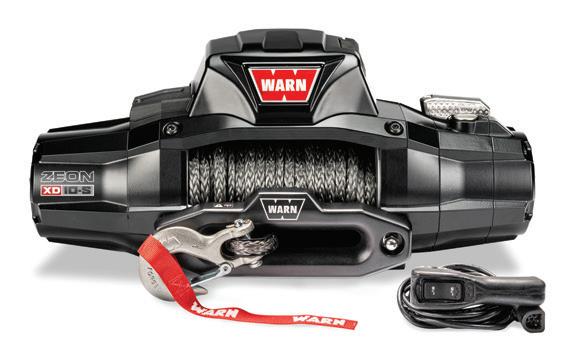



Dual-Tech is the redesigned Scorpion dual-winch Side-Puller. Its unique LoPro design provides maximum winching power, truck stability, and visibility through the rear window. This groundbreaking configuration for the towing industry features a pair of Warn 9,000lb winches, and two independent jack legs with multi-position legs and feet. In addition, there’s full visibility through the rear window for optimal positioning of the pylon and Side Puller, as both are easily adjustable.
The Scorpion is quick and simple to maintain, with grease fittings placed in the most accessible locations to get back in the field as quickly as possible. Each unit comes equipped with an 8-function wireless remote system for optimal precision and maximum operator safety, while having the option for manual operation as needed.
The carrier’s practical design also gives operators the advantages of having one of the most useable deck spaces in the industry, along with the Scorpion’s durable and compact setup that provides winching capabilities from any angle, much needed in many recovery situations.
Dual-Tech emphasizes simplicity, functionality, and longevity. The Scorpion Side-Puller meets all these requirements for a speedy, safe, and successful recovery. The Scorpion Side-Puller can be mounted on any new light-duty DualTech carrier, and is available through the company’s parts department.

Demonstrating what can happen when equipment ratings are
By Terry Abejuela
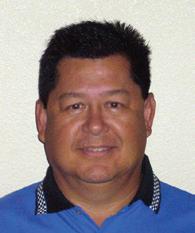
Before attempting to perform any recovery operation, a tow truck operator must have a thorough understanding of the equipment ratings. Lack of this knowledge may result in overloading and eventually cause costly damage to the equipment or even result in catastrophic failure. Many injuries and fatalities have occurred in the towing and recovery industry as a result of equipment overloading. The old saying that, “a chain is only as strong as its weakest link” is absolutely true and tow operators should carefully inspect all load-bearing equipment to ensure that a weak link is indeed, not overloaded.

limited to the recovery boom, winches, wire rope, chain, hooks, synthetic straps, snatch blocks and shackles. This article focuses on the boom, winches, wire rope and snatch blocks. The ideal place to start is with the OEM (Original Equipment Manufacturers) operation manual for the recovery equipment. Understanding and abiding by the manufacturers intended use, operating instructions, working-load limits (WLL) and proper maintenance are critical to the safe operation of the equipment. The equipment operator is the person ultimately responsible for handling the equipment safely.
While we will be using Working Load Limits (WLL) common for light-duty equipment as examples, much of this information applies to medium- and heavy-duty recovery equipment as well. Of course, the WLL will be higher to handle the intended loads.
Most towing and recovery equipment will be marked or have a ratings plate attached to easily identify the Working Load Limit.
There are many pieces of equipment used in a recovery operation, including but not
Most towing and recovery equipment will be marked or have a ratings plate attached to easily identify the WLL. However, it is not uncommon for markings and rating plates to be missing, covered with paint, or completely illegible. If the equipment is missing the rating plate, contact the OEM to determine the ratings.

Most light-duty, single-winch recovery booms are rated about eight tons or 16,000 pounds when fully retracted, and about 4,000 pounds fully extended. Some OEMs require a minimum boom elevation in order to achieve the WLL. It is not always indicated on the ratings plate, but most light-duty recovery booms require a minimum boom elevation of between 10 and 30 degrees.
These ratings generally apply to working directly off the rear of the recovery unit. Side-pulling off the boom should be avoided, as OEMs don’t typically publish ratings for side-pulling from the recovery boom. Of course, sidepuller units are intended to pull from the side of the truck, but the side-puller boom is mounted perpendicular to the truck since it was specifically designed and intended for this function. Generally speaking, when a side-pull is required on a conventional recovery boom, it is better to use a snatch block to redirect the pull from the tailboard of the wrecker unit in order to avoid side-pulling on the recovery boom.
Most light-duty towing and recovery trucks are equipped with a winch that has a WLL of 8,000 pounds. Winches are rated on the first layer of the winch drum. When the wire rope is on the second layer of the winch drum, the rating will be reduced to about 6,700 pounds. When the wire rope is on the third layer of the winch drum, the rating is reduced to about 5,700 pounds.
Most winches used on light-duty towing and recovery trucks are equipped with 100 feet of wire rope, so they normally will not have more than three layers of wire rope on the drum. If it has more than 100 feet, however, it may get into a fourth layer, which will reduce ◀


the WLL to about 5,000 pounds.
The 8,000-pound winch rating also requires at least five wraps of wire rope around the winch drum. The wire rope is often attached to the drum with a set screw which is not intended to hold any load. With at least five wraps of wire rope around the drum, the rope will tighten on the drum and hold the load before any load is placed on the set screw.
The towing and recovery equipment manufacturers’ rating plate may only provide the rating for the winch on the first layer. To find the rating for additional layers, examine the rating plate from the winch manufacturer that is attached to the winch.
Most light-duty towing and recovery equipment winches are equipped with 3/8 6X19 IPS Fiber Core wire rope which has a WLL of about 3,500 pounds. In order to achieve this WLL, the wire rope must be terminated correctly, such as with a Flemish Eye or turn-back termination with a wire rope thimble and a swaging.
This type of wire rope terminated with wire rope clips will not be rated at 3,500 pounds. If done correctly, the maximum rating for a wire rope terminated with wire rope clips is about 75 percent of the WLL, as long as the clips are installed as intended. Improper use of the wire rope clips will further reduce the WLL.
There are other repair type terminations that can be used in the field, but they might not provide 100 percent of the WLL. Wire ropes commonly have a slip hook attached that has a three-ton or 6,000-pound rating. Look at the hook for markings to indicate the WLL.
When performing recovery work, attach the wire rope slip hook with the tip or open side of the hook facing up. The load must be applied within

45 degrees of the center of the bow of the hook to achieve the WLL. Loads applied outside of 45 degrees of the center of the hook will drastically reduce the WLL of the slip hook.
Most light-duty towing and recovery trucks are equipped with one or more snatch blocks that have a four-ton or 8,000-pound WLL. Make sure that the sheave in the block is designed to accommodate the size of wire rope on the recovery boom.
When using a snatch block with a slip hook, make sure to attach the hook with the tip or open side of the hook facing up. Loads must be applied to the slip hook on the snatch block within 45 degrees of the center of the hook. Loads aligned outside the 45 degrees from the center of the hook will drastically reduce the WLL of the snatch block. The snatch block must be free to align with the pull. Any side-loading of the block, along with tip loading, back loading, or side loading of the slip hook on the snatch block, will reduce the WLL.
a fixed block (change of direction) or as a running block (reducing line tension), and how the block is used determines its rating. The 8,000-pound rating is when the block is used as a running block. When the snatch block is used as a fixed block, it is only rated at 4,000 pounds. The load on a fixed block will change based on the line angles. The smaller the line angle, the more tension the block will experience. For example, if the line load is 1,000 pounds and you are using a fixed block for a change of direction, and the line angle is zero, the snatch block load will be 2,000 pounds. If the line angle is 90 degrees, the load on the block will be 1,410 pounds. When the line angle gets to 120 degrees, the load on the block will be 1,000 pounds.
It is important to understand that the WLL for the recovery equipment is dependent on the load being applied gradually. Shock-loading of the equipment must be avoided. Damaged or equipment failure can occur when the equipment is shockloaded, even if the load is within the WLL.

Winches
While the equipment ratings noted here are common, they may not apply to your specific equipment. Make sure that the WLL you use comes from the OEM.
For your safety, all as well as others on scene, it is critical that tow truck operators understand the recovery equipment ratings. In every instance, be absolutely sure that the loads placed on any load bearing equipment is within the WLL of the equipment being used.
Snatch blocks can be used as either



Brass lamps and wooden-spoke wheels give this Locomobile a classy treatment.
By Steve Temple
Although longtime towers know the name Ernest Holmes, some younger ones haven’t heard of him, nor the towman’s term “Holmes Tree.” There’s a new generation of towers that just aren’t familiar with this old-school slang.
To help them set the record straight, the International Towing Museum in Chattanooga, Tennessee is certainly worth a visit. In addition to displaying dozens of beautiful classic tow trucks (such as the Locomobile featured here), detailed plaques provide a wealth of fascinating historical details.
Also, a sign on Market Street, located just a few miles away from the museum, marks the spot where Holmes opened his auto repair garage and invented the twin-boom wrecker in 1916. (This groundbreaking design was born out of necessity when he was unable to recover a Ford Model T from a creek bed with a single-line wrecker, since he had no way to brace his truck).
Holmes went on to pioneer and patent many innovations in the towing and recovery industry.
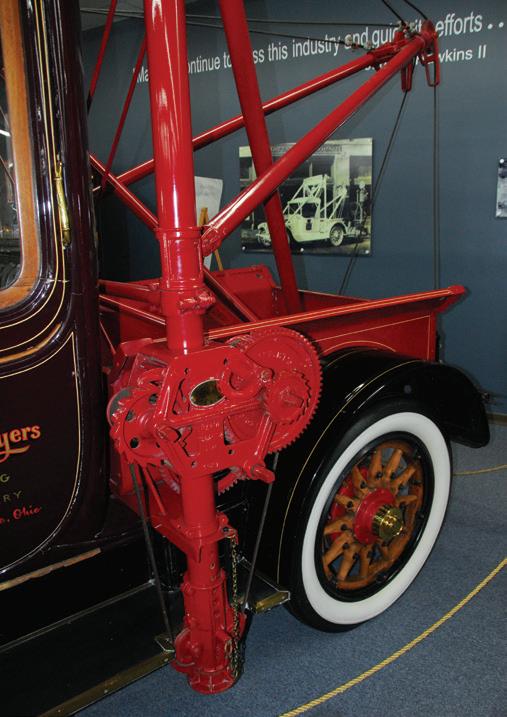




He was also the manufacturer of the first military wrecker, and supplied thousands to allied forces during WWII.
As for the Locomobile (a combination of the terms locomotive and automobile), the manufacturer was founded in 1899, making it one of the earliest car manufacturers in the advent of the automobile age. This particular truck was fitted with a hand-crank Holmes 485 unit, rated at four tons (two per boom). These booms would swing outward on each side for easier access to a casualty vehicle. Outrigger legs on the wrecker body ensured the stability of the wrecker while handling a recovery. Back in the day, Holmes sold the versatile 485 unit for exactly that number: $485.
This 485 was mounted on a 1913 model of a Locomobile. Manufactured in Bridgeport, Connecticut, this jaunty rig sold for about $6000. The truck’s sixcylinder engine delivered a mere 82 horsepower, but it got the job done.
Getting back to our term mentioned above, what exactly is a Holmes Tree? Although not a specific piece of towing equipment, it was a practical way of attaching a snatch block to a nearby tree to change the direction of a wire rope's path, and also serve as an anchor. This method allowed tow trucks to handle difficult recoveries when straight-line winching from the tow truck's rear deck wasn't possible on narrow back roads. Tying off to a Holmes Tree (and using some protective wrap to prevent the chain from cutting into the trunk’s bark), gave much-needed stability to the tow truck while winching casualty vehicles back to the roadway.
So, younger towers owe much to Earnest Holmes and his tow truck innovations, along with the tried and true rigging methods still in use today.
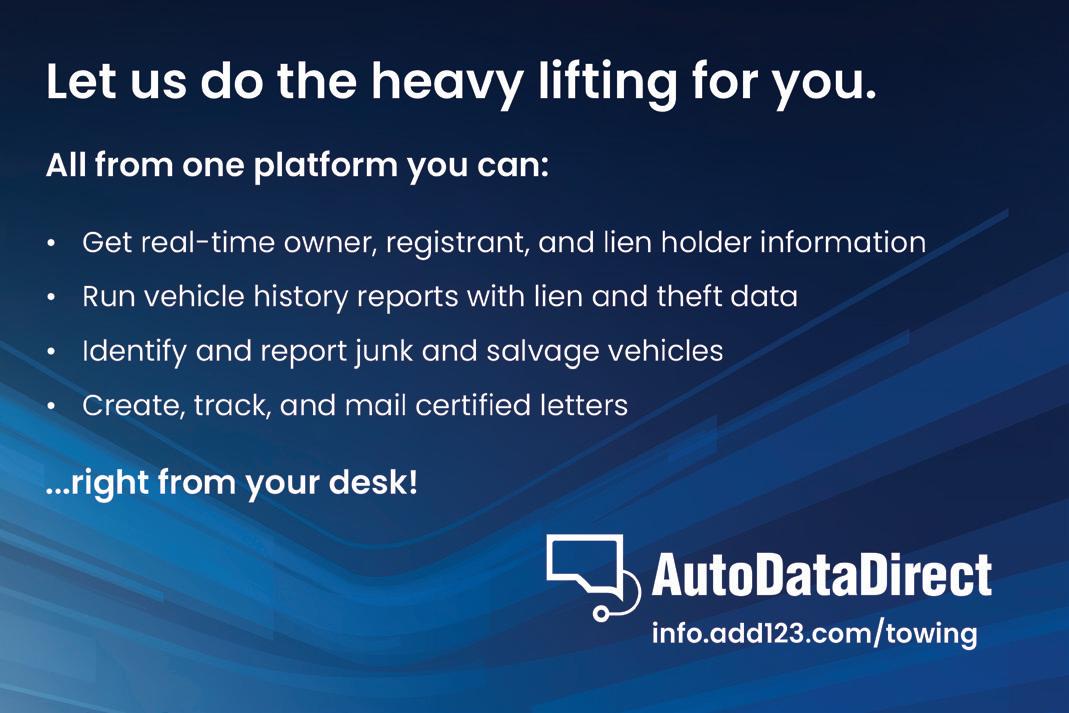

Most people are not aware that 359,000 dogs were euthanized in the Unites States in 2023. That’s more than 900 each day. Although I’m not an Animal Rescuer, I am certainly an animal lover, and I grew up in a household where all of our pets were adopted from shelters.
As an animal advocate, I recently started following ‘Stephanie’s Shepherds” on Facebook after hearing about it from a friend. One particular group called “Dogs Matter: Adopt, Foster, Share” caught my attention as it has nearly 9,000 members from all over the world. On a daily basis, these members post pictures of dogs that are in dire need of immediate rescue, along with the date and time they are scheduled for euthanizing. Then, just a few days later you might see the word “saved” under the same dog’s photo, but most often the follow-up post will read “RIP.”
These healthy, beautiful, and often young animals are being disposed of as easily as expired milk, and all because there is no longer any space for them.
Several local rescue centers are retrieving these dogs from notorious “kill centers,” often located in the South, in a desperate attempt to save them before they are put to death. I’ve heard countless heartbreaking stories from rescue owners that have
left them feeling overwhelmed and on the verge of emotional breakdowns from their inability to save them all. The pictures are both disturbing and distressing.
The heart-wrenching stories of the fate of these dogs sparked me to sit down and come up with a solution.
As a real estate agent for more than 20 years, I know firsthand that in the Dutchess County, NY area, there are apartment complexes that don’t allow at least ten particular breeds of dogs in rentals. Sadly, independent landlords follow much the same guidelines, and mostly for insurance purposes.

and installed a trapdoor (doggie door) leading into an interior garage or office?
Furthermore, no matter what the size or breed, most landlords will only allow a dog that is an Emotional Support Animal (ESA), as they are legally bound to do so. In actuality, the current economy is provoking this euthanizing scenario. With the high cost of houses and elevated interest rates, many people are forced to rent, and are finding themselves having to “re-home” their dogs because of the restrictions.
When considering ways to save these dogs, it occurred to me that towing and recovery businesses usually have large, gated yards. In addition, they don’t have an abundance of customer interaction, and you almost never see children on the premises. These facilities often require security and companionship, and rescue dogs can provide both. Another added benefit according to a shop owner who has 2 dogs is that when an “irate customer gets loud, the dogs bark from behind the door and that usually makes the customer nervous and calm right down.”
Then after the customer leaves, the dog gives sweet kisses to make the owner feel better!
The Solution: What if a towing/ impound yard gated off an area
I was told by the Humane Society that as long as there is food, water, and shelter, this is perfectly fine. And, given that many people leave their dogs all day while they’re at work, the rescued dog in the tow yard would actually be alone at night (and probably sleeping, anyway), but in the company of at least a small staff of adults during the day.
When I started calling around to see if this was a feasible plan, I was told by some that they couldn’t have a dog because of insurance purposes. Not willing to accept this as an answer, I contacted several business insurance companies and found plenty that allow all breeds of dogs, and some that aren’t even concerned with pets on premises, if it’s not an animal-related business.
Maybe you never thought of having a dog at your shop, but as the saying goes, “A dog is man’s best friend,” so if you’re looking to add a furry friend to your work family just like Murphys Auto Center in Salt Point, NY, please contact your local Animal Rescue center and adopt a “Shop Pup Guard” and save a dying stray today!
To read more about my mission, check out my Facebook page at https://www.facebook. com/share/5rMhkPcm8hXASnBC/?mibextid=K35XfP
Kristin Kramer, CEO/Founder Buddy Hoppers Wappingers Falls,
NY

By Stephanie Marchese
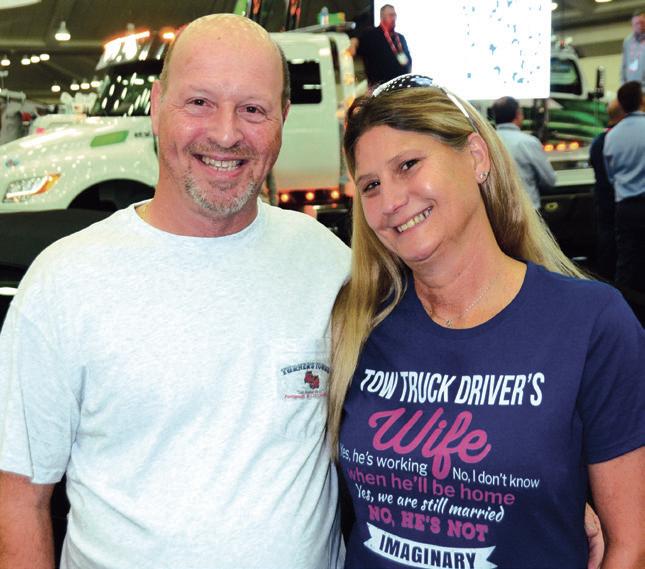
When you first set foot into the halls of the AT Exposition in Baltimore, you probably don’t expect to see more than the 250+ vendors enticing you with their wares, or the dozens of decked-out tow trucks displayed in all their majestic beauty, or even the 100+ piece marching band followed by a 15-foot stilt walker. But we have come to expect the unexpected at our tow shows, and last year was no exception. Amidst the grand AT Exposition, a once-in-a-lifetime love story was unfolding and had come to Baltimore for the ultimate celebration.

During the decade of disco and hard rock, Billy and JoAnn were the best of high school friends, but never sweethearts. It took them eight years post schooling to figure out that they did indeed, like each other in “that special way” and finally started dating.
JoAnn recalls that one of the best dates they had, maybe the best date she can remember ever having, was when she and Billy went to the American Towman Exposition in Baltimore, Maryland. Billy was already a tow truck driver and had dreams of having his own tow company one day, and JoAnn loved the world that made Billy happy.
Despite this promising start, after five years together they decided to part ways. Billy went on to follow his tow business
dreams and a few years later, JoAnn got married and started raising a family.
Fast forward 27 years and life looked quite different. Both were divorced, single parents, and not enjoying the dating scene at all. That is, until one Superbowl Sunday in February of 2022 when a mutual friend invited them both over to a Superbowl party. Without missing a beat, Billy and JoAnn picked up right where they had left off in high school, as best friends.
“It was almost as if no time had passed,” recalls Billy. They talked, laughed , and reminisced throughout the entire game, not caring which team was winning or losing, and by the end of the night, they were once again “an item.”
Billy always knew JoAnn was “the one” and was not about to waste another minute of not having her in his life, forever. Crying and stuttering, unable to get the words out, is how JoAnn describes his fumbling proposal, and she finally had to ask, “What are you trying to say?”
Billy composed himself enough to ask “Will you marry me?” Her response, “What took you so long?” which was interpreted as a “Yes” by all present!
The fairly-tale romance was followed by a fairy-tale wedding last August, complete with a Cinderella wedding dress picked out by Billy, and a three-tiered staircase for their newly combined family

to pose and wish the happy couple everlasting love.
When it came time to plan the honeymoon, Billy asked JoAnn “Where do you want to go, sweetheart?” Without pause, JoAnn answered, “I want to go to the American Towman Exposition in Baltimore!”
When our AT staff met up with
the happy couple in Baltimore in November, they told us their story and when we said that we’d like to share it with our readers, Billy started crying on the spot. Who would have thought that this roughand-tumble tow operator, owner of two 35-ton Century wreckers and his very own tow business, Turner’s Towing Service in Portsmouth
Virginia, would be such a softie? Obviously, JoAnn saw that love has everything to do with it, and it’s not just a second-hand emotion.
If you have a colorful story to share, come see us at the AT Booth at the upcoming American Towman Exposition, November 21-23, 2024, at the Baltimore Convention Center.


By Brian J. Riker
Cybercrime is one of the fastest growing crimes worldwide. According to a recent article published by Forbes Magazine, cyber criminals can penetrate 93 percent of all company networks, usually taking less than two days to infiltrate a network. The most popular way is compromised credentials such as simple passwords. This accounts for 71% of all data breaches.

Brian J. Riker is a third-generation towman, with 30 years of experience in the ditch as a tow operator, and president of Fleet Compliance Solutions. He specializes in helping navigate the complex world of federal and state transportation regulatory compliance. He can be reached at brian.riker@fleetcompliancesolutions.net
These attacks are becoming more sophisticated every day, giving great concern to security experts worldwide. Tow company managers have probably noticed a dramatic increase in the number of phishing attempts coming through to their businesses and cell phones. This indicates that there is some credibility to the general warning issued by the United States Cybersecurity and Infrastructure Security Agency (CISA) last year:
“All organizations are at risk of being targeted by ransomware and have an urgent responsibility to protect against ransomware threats.” (As implied by its name, ransomware is a type of malicious software designed to block access to a computer system until a sum of money is paid.)
These threats are real, and although not often mentioned in the press, towing is a critical part of the U.S. transportation infrastructure, making it a credible target. For tow managers who haven’t reviewed their cybersecurity plans recently, or don’t actually have any in place, now is the time to think seriously about updates to policies, procedures, and just who qualifies for connected access. CISA is asking transportation providers to thoroughly review all their procedures and heighten their cybersecurity posture.
Some tow managers might be wondering, "What is phishing and how can it affect me?” Simply put, phishing is when a hacker uses some public information or otherwise sends a false email or text message trying to get unsuspecting recipients to click on a link. This will then allow a phisher to install malware on a device or network and do harm to both the data and the system.
Recently, a potentially damaging phishing threat was geared toward anyone with a US DOT number and almost hit one of my clients. Fortunately, this attempt was caught before any damage occurred.
The bogus email appeared to be from the Federal Motor Carrier Safety Administration regarding the New Entrant audit, directing recipients to a clone of the official website that requested details about their trucking business. Once they had all the business details, the phisher could then use this information to steal an identity for scamming freight loads or other trucking companies.
How does this affect the average tower? Besides the severe disruption to both a business and personal life, poor cybersecurity allows access to sensitive business records or computer systems and can cost tens of thousands of dollars (or even more) to repair or replace.
Don’t think that only the office staff that needs training on these issues. Anywhere a digital device is used is a potential entry point for malware. From tow truck driver’s cell phone (especially if
they use their own device for both business and personal use) to the data terminal in a tow truck, or even the Wi-Fi connection popular in the newest vehicles—every place there is a connection to the internet or between multiple devices is a target and potential weak spot.
Imagine if a tow company’s entire dispatching system suddenly went dark, its internet phone system stopped working, and all billing records were erased. Would the average tow business have the ability to recover? Even worse, what if the data bus on a tow fleet was hacked and the trucks rendered inoperable, or worse yet disabled while in motion and resulting in a wreck?
These are not scenes from a science fiction movie, but rather a likely scenario during a widespread infrastructure attack by hackers,
especially those backed by a foreign state. Consider the damage caused when the Colonial Pipeline was hacked back in May 2021, or the time in 2015 when a hacker took control of a Jeep Wrangler remotely, disabling its engine, while it was being driven by an editor from Wired Magazine?
Just last month, Jeremy Daily, an associate professor at Colorado State University, and a few of his students were able to hack into a truck’s CAN BUS and take control of the accelerator pedal remotely by using off-the-shelf hardware. They exploited a vulnerability built into nearly all the US DOT-mandated electronic logging devices currently on the market. It is not a stretch of the imagination to realize that this same exposure is likely present in most devices that connect to a vehicle’s data bus and also have a connection to the internet.
These attacks have been refined into very complex assaults, with hackers claiming to be a customer service representative from a vendor, or maybe even pretending to be an internal employee of a company. They use information found on social media to gain the trust of potential cybercrime victims.
This is the process of using social engineering to allow for spear phishing, which is a fancy way of saying they read Facebook posts and then target individuals or their company, specifically. Those innocent appearing games and surveys asking about the first truck you drove or where grew up, may appear to be just simple fun. But more likely they are purpose-built to gather the answers to security questions or other information so the attacker can gain misplaced trust.
Some of the more common ◀
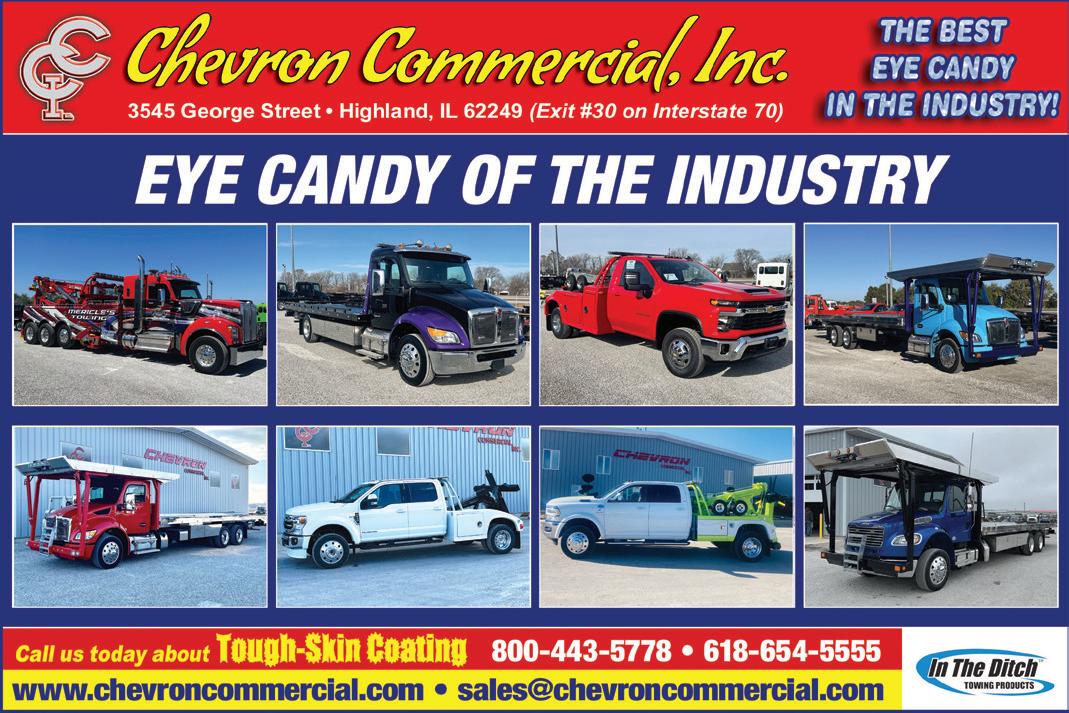
of these attacks target financial information by claiming to be your bank, an online retailer or other such institution, and their messages are getting harder to detect as suspect every day. Others merely aim to create havoc and destroy information, while others attempt to ransom personal data for a large sum of money.
Deep-fake videos are now easily obtainable, with several being used to steal money from large corporations. The largest known attack of this style resulted in the loss of $25 million when a scammer, pretending to be the company’s Chief Financial Officer, convinced a legitimate employee of a firm to wire transfer money, all by creating a fake conference call with what looked like the senior leadership team of the company.
Cybersecurity is not just all foreign national hackers working in some dark, remote basement. They often use physical breaches to gain access to private networks. Towers are especially vulnerable to this as they often allow customers inside company trucks and offices, unwittingly providing access to personal belongings.
Physical threats include accessing an unlocked tablet, cell phone or computer when no one is looking, swapping a cell phone charger cord with a seemingly innocent cord, but one that actually has a backdoor key or other malware hidden inside. Or outright stealing a device and using it to access information before anyone notices it's missing.
Even curious towers plugging in a random USB drive or memory card they found lying around somewhere could introduce malware into their system. Hackers will even go so far as
to plant tempting devices for others to “steal,” and then hook infected devices up to their own network.
With all the modern payment methods currently accepted, it’s highly possible to send a highquality, yet fake, payment link or introduce malware into a network using wireless data exchange such as tap-to-pay or radio frequency identification skimmers. This type of fraud is very popular with credit card payment terminals, especially those used at the fuel pumps or in remote stores.
Be very careful of clicking any text links or email links, even when expecting them, without first closely inspecting them. Examine messages for poor grammar, misspellings and substitutions like the number zero in place of an uppercase letter “O” in an email address or website ◀
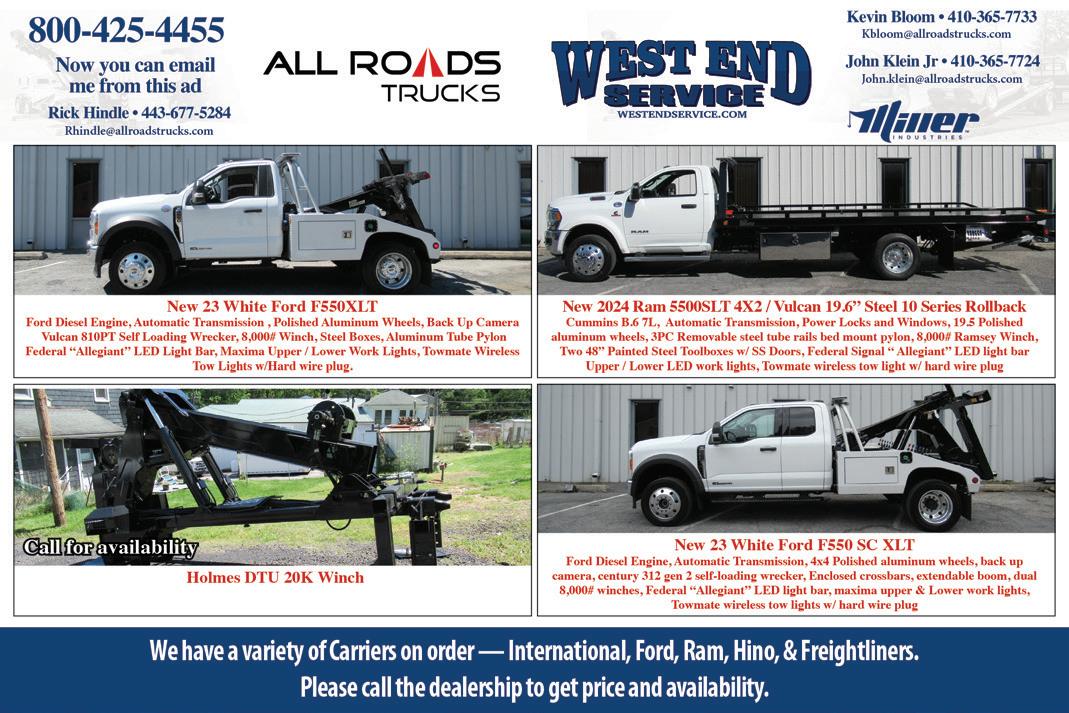

Towers are especially vulnerable to hackers, as they often allow customers inside company trucks and offices.
name. These are not simple mistakes, as just one letter or number different will link to a completely different website. And, even if a “page not found” error message is received, it is likely already too late when it’s a phishing attack. It is probable that the landing page has already loaded malware into your system. It should be obvious that having up-to-date anti-virus software on all your devices, not just computers, should be part of business protocol. Cell phones, tablets, smart watches
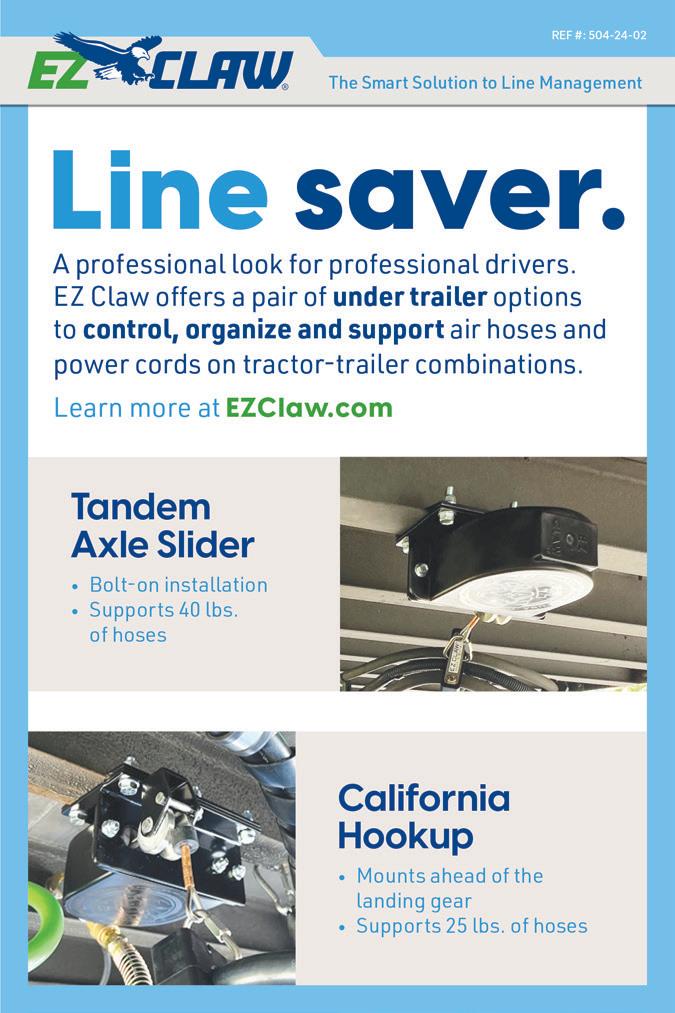
and even truck data terminals are all vulnerable to attack, easily providing a gateway into your network or personal information. Best practices include limiting wireless sharing such as Air Drop or Bluetooth to only trusted and recognized devices, and avoiding public Wi-Fi hotspots like the plague unless a Virtual Private Network (VPN) is being used.
Passwords and user IDs are likely the weakest links. They should be something easy to remember but hard to guess (and especially not “password”!) Most security experts recommend:
• At least 16 characters with a mix of letters, numbers and special symbols.
• Always avoid using family names, birthdays or other easyto-find information.
• Never repeat the same pattern.
• Use a different password for every account, especially critical accounts, so that if your information is compromised on one account, the damage can be controlled. All too often people use the same user ID and password for everything, posing a huge security risk.
Two-factor authentication is a great tool to control access to critical accounts. Not only would a hacker need to properly guess the login credentials, but they would also need to convince you to send them the text or email code just received. Hint, if anyone requests a code just received, it is a phishing scam. Do not reply and report it to your company’s IT security team.
Many cyber experts also recommend using password generator software, which is an app that will create random access codes and manage all your online activity. Or, do it yourself by changing passwords on a rotating basis


and keeping them different for each account and system.
Other physical security solutions include immediately changing the router or access point network names, as well as admin login credentials. Most of these devices come with easy-to-guess or publicly known administrator credentials that must be reset as soon as the device is installed. Do not leave the default settings, even for a guest network.
Speaking of guests, never allow a guest to use your main wireless network. Always create a separate, restricted network for guests and others not under your direct control. Change the access codes frequently and limit who is granted access to your guest network.
Consider keeping remote backups of critical files off-site, perhaps in multiple locations,
such as a cloud-based service and a physical hard drive located at another facility, or even at home.
Lastly, always lock your computer or cell phone, even when away from it only for a moment. Set a short timer to blackout the screen, and be aware of who is looking over your shoulder, especially in crowded public places. Never leave passwords or usernames written down in easily accessible places such as a wallet, backpack or tacked onto the office wall.
These precautions might sound a little over-protective, but today’s cyber world is rife with risks. For more information on this threat warning and more, visit the US Cybersecurity and Infrastructure Security Agency’s website at https://www.cisa. gov/shields-up


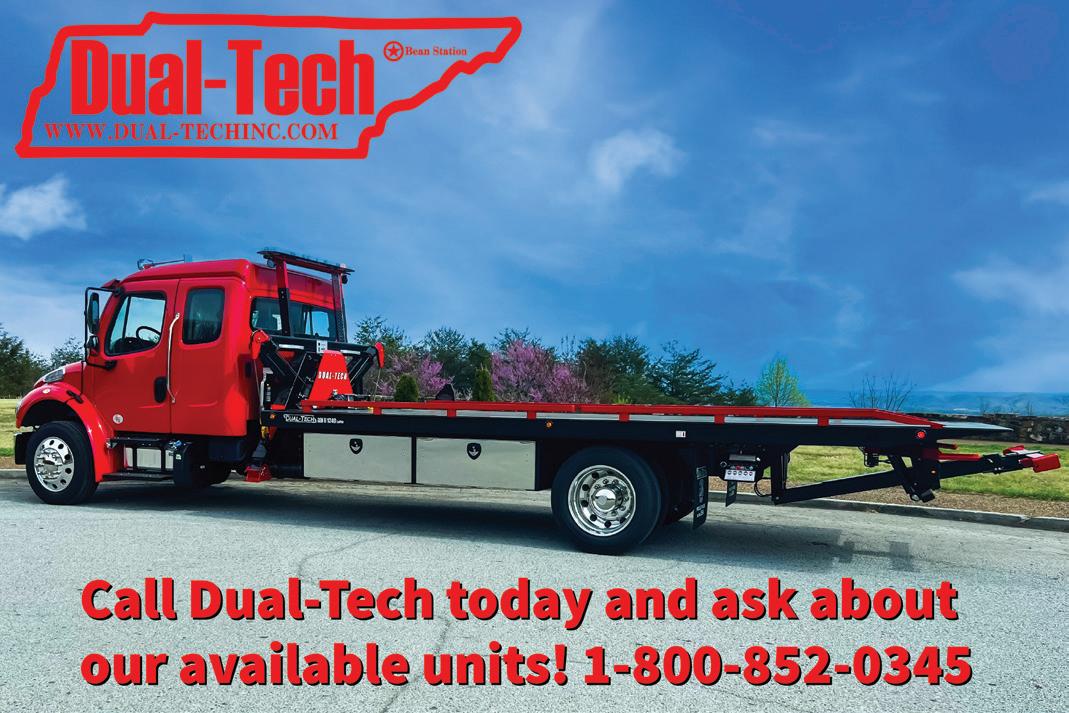

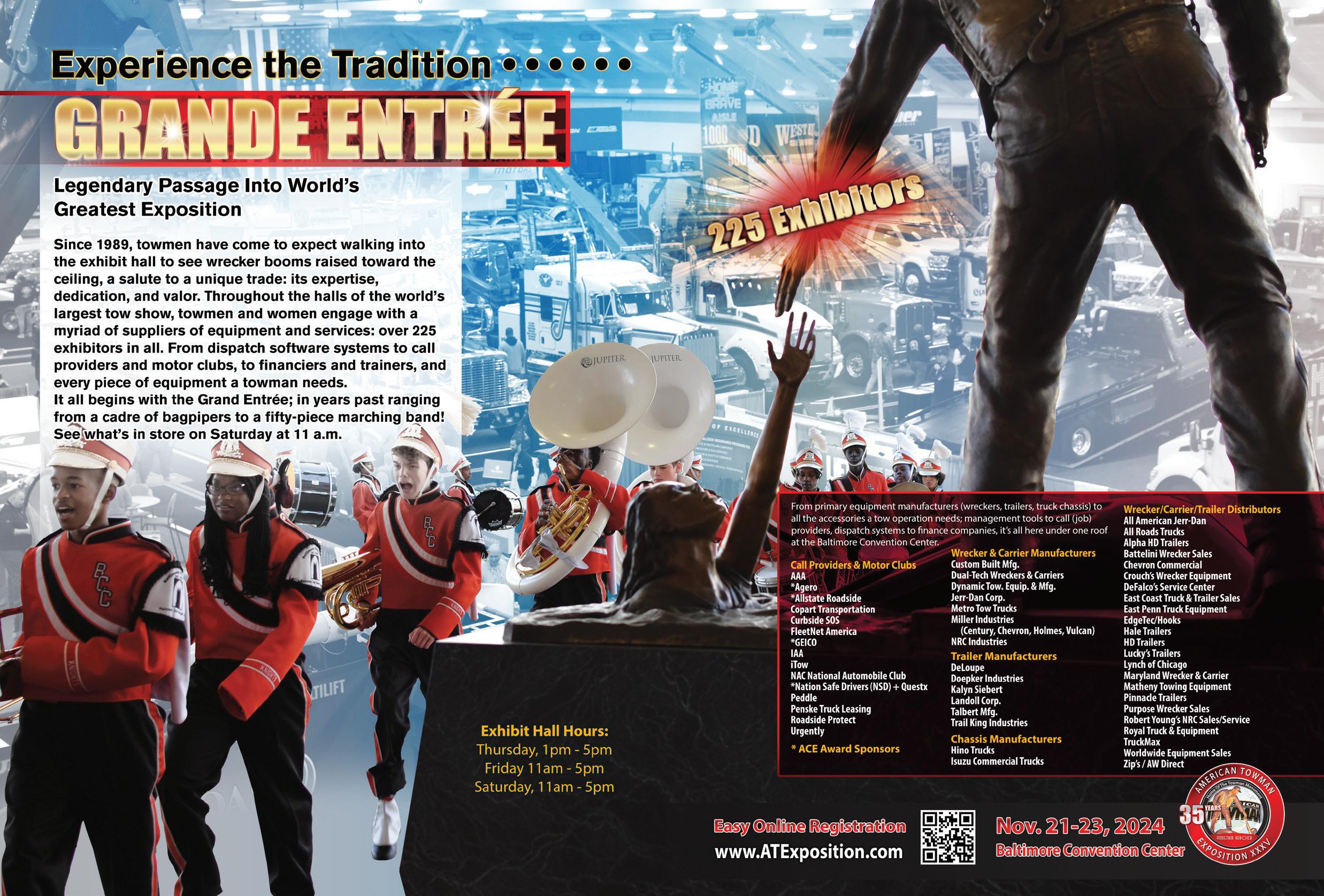



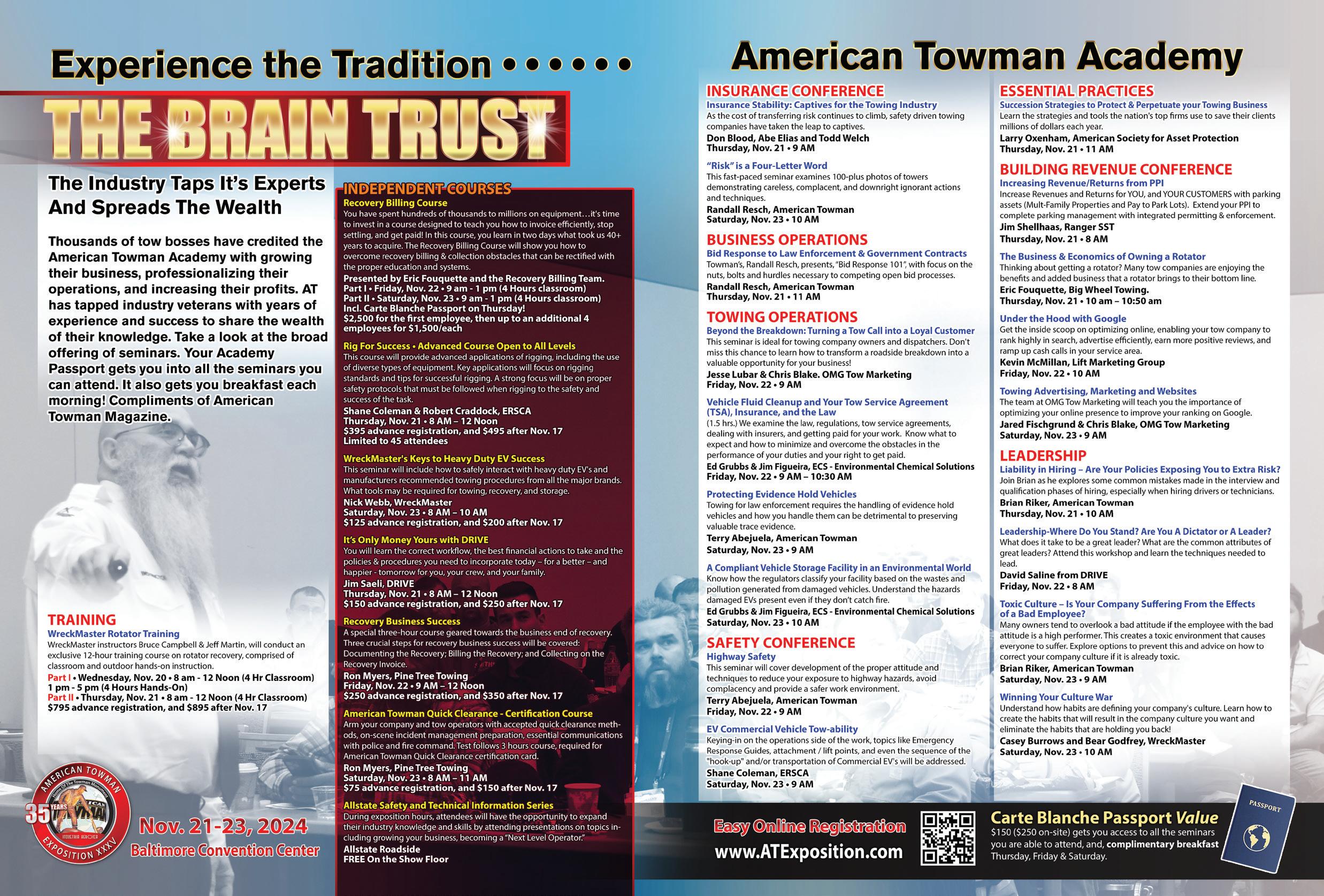





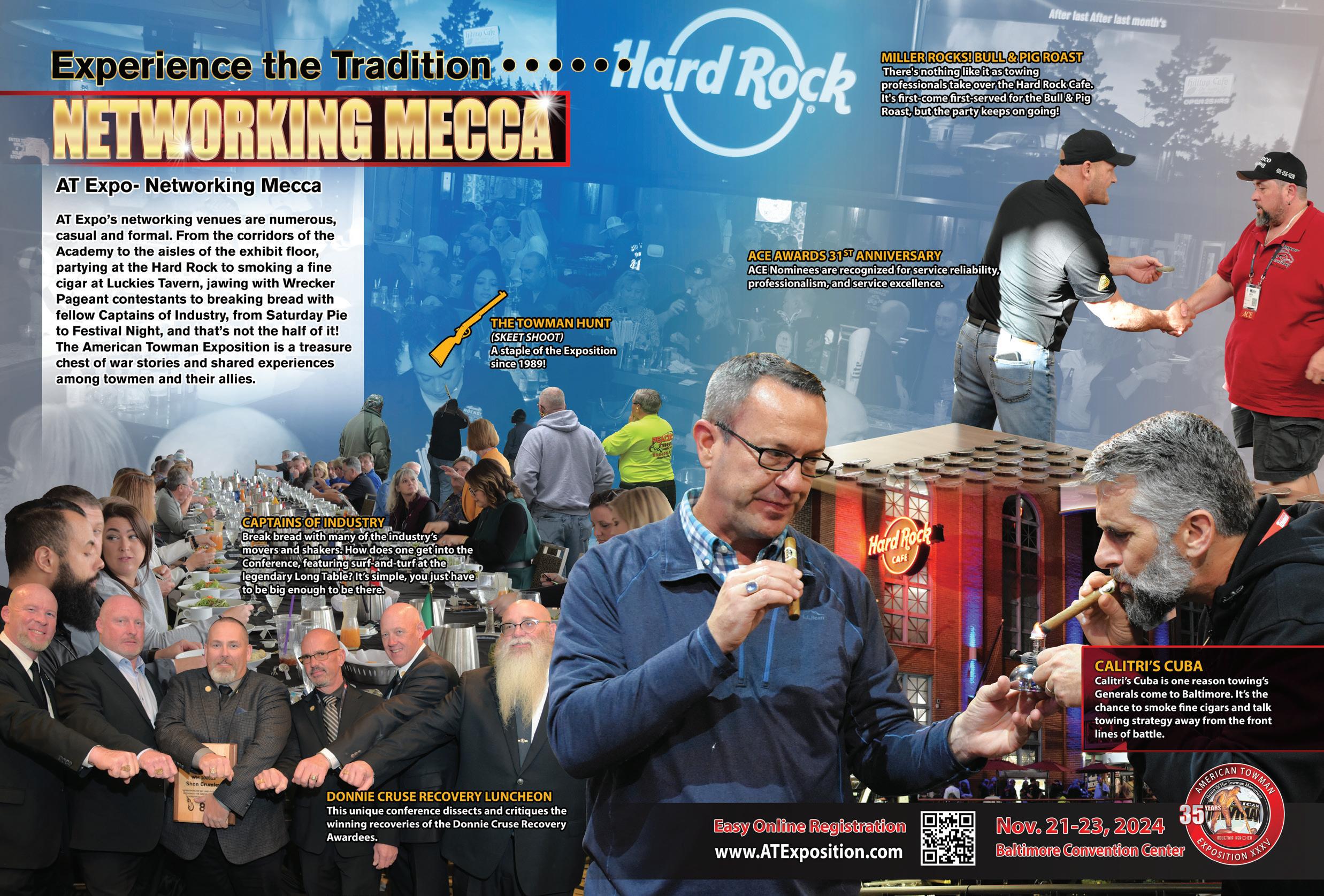






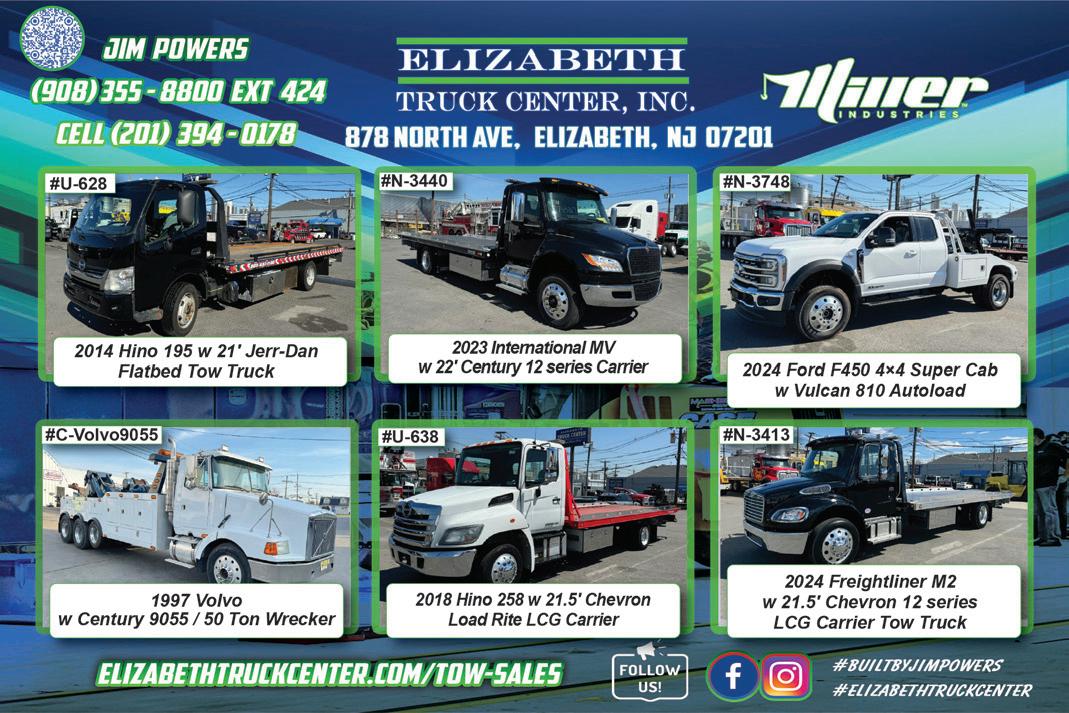



Courtesy of WreckMaster
Talk about a hefty burden!
After a heavy-haul transporter slipped off the edge of a roadway, on February 20, 2023, US 60 had to be closed near Kevil, Kentucky. The mining
truck chassis it was carrying had broken free of its load-securing devices and slid off of the trailer. This particular mining truck is capable of carrying a payload of up to 150 tons. The CAT 785C’s
Presented by American Towman Magazine and WreckMaster
chassis alone weighs over 164,000 lbs. The gross combination weight of this casualty was a whopping 268,000 lbs.!

2023 Winner: Tri-State Towing and Recovery
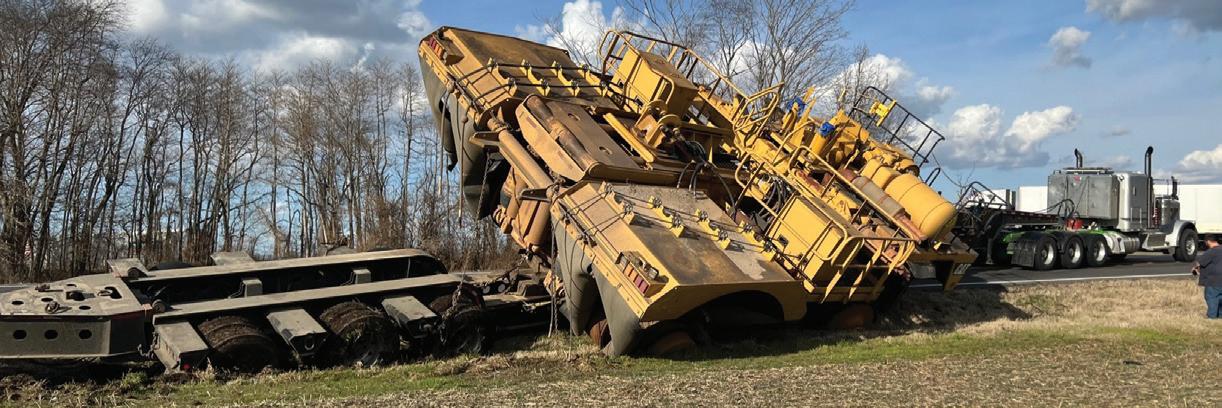





To recover this massive machinery, Tri-State Towing and Recovery’s crew positioned a pair of NRC CSR 65 rotator wreckers alongside the rear of the CAT. The tow operators assembled several multi-part winch lines from the wreckers, and then installed the lines on both the 785C and the heavy-haul beam trailer.
A coordinated effort by the operators raised and controlled the haul truck. While suspending the casualty, winching lines from the rotators slid the rear of the trailer out of the ditch. A heavy-duty wrecker from Frank’s Tire and Wrecker Service winched the tractor and trailer from underneath the load, and successfully moved both away from the action area.
The mining truck was then lowered to the ground and operators repositioned the wreckers to execute the second phase of the recovery. An all-terrain crane, provided by Lent’s Towing and Recovery of Paducah, KY, was rigged to the rear of the CAT. Multiple shackles and round slings were used to attach the crane’s block to the load. NRC rigging plates, snatch blocks, shackles and Terry Chains connected wire ropes from each of the CSR 65s to the front of the 785C.
Next, the winches were engaged and power was steadily applied to three areas of the load, in order to level it. The rotating boom of each unit moved in synchronous fashion, lifting the haul truck out of the ditch. The
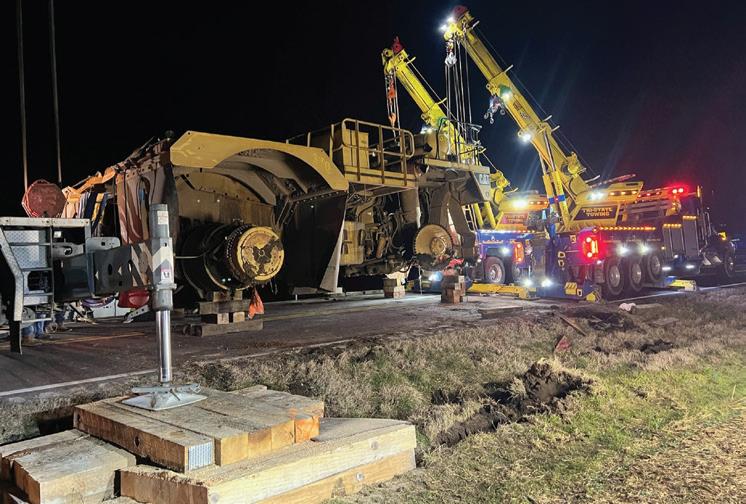

load was lowered onto hardwood cribbing that had been stacked strategically on the paved surface.
In conjunction with the transport company, operators winched the beam trailer underneath the mining truck’s chassis. Load securement procedures then began. The wreckers executed a final lift of the front of the load to remove the hardwood dunnage. Operators installed the remaining tie-down chains and brought this difficult
recovery to a close.
The ability of Tri-State Towing and Recovery to work seamlessly with other companies, along with the knowledge, experience and confidence of Frank Hammond, Lance Wayne, and Steve Bell, were all truly remarkable. In honor of the legacy of Donnie Cruse, WreckMaster congratulates Franklin Hammond and Tri-State Towing on a job well done.
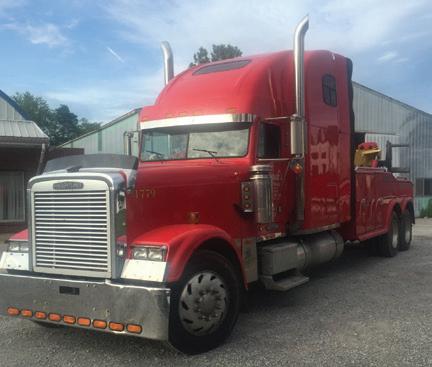
Tri-State Towing and Recovery is located in Evansville, IN and covers portions of three states: Indiana, Kentucky, and Illinois. The company provides full-service management of incidents involving automobiles, commercial motor vehicle and everything in between. Not many days pass that their service isn’t required to mitigate some sort of incident.
Tri-State operator Franklin Hammond is a multi-talented family man, a loving husband and dedicated father. Another passion is fitness. His running shoes probably have as many miles as his Kenworth. Frank is committed to training, and not just for towing and recovery. He’s constantly honing his firefighting skills along with many other disciplines of the rescue trade.
Cross-training with fire and rescue has ensured that Tri-State is a trusted resource to area first responders. Their expert skills and well-equipped wreckers have been proven life-savers on more than one occasion. Area firefighters, rescue technicians and medics are fortunate to have Frank Hammond and the TriState Team at their service.
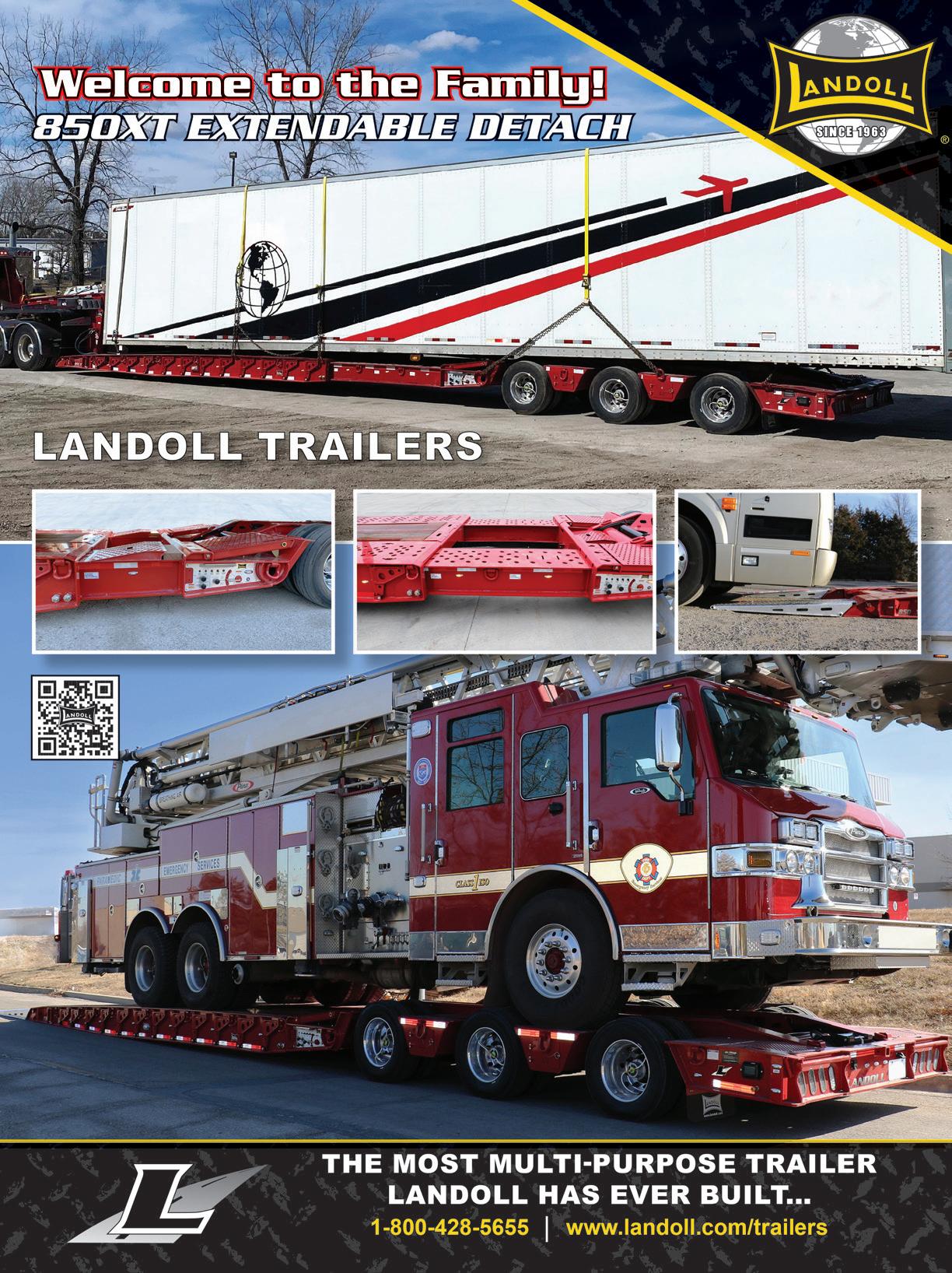

Peterbilt has announced the availability of a new, low NOx (nitrogen oxide) PACCAR MX-13 engine in the Models 567, 579, and 589. This engine meets the CARB Omnibus Regulation and features redesigns of the internal hardware and the aftertreatment system to effectively reduce NOx emissions.
The larger volume aftertreatment system includes an innovative, compact twin assembly featuring a 48-volt generator located in the flywheel housing, and an electrical heater located in the inlet to provide lower NOx output. The internal hardware now features a larger volume mixer, longer selective catalytic converter (SCR) and an improved and more durable NOx sensor design with increased longevity for improved uptime. These features allow Peterbilt customers to achieve increased engine efficiency and fuel economy while continuing to meet stringent CARB emissions regulations.
The low NOx compliant PACCAR MX-13 engine combines the proven diesel powertrain with next-generation technology. It is available in two ratings with a flat torque curve, providing performance across a wider range of RPMs for excellent drivability and fuel economy. This includes a high-performance 510 horsepower rating with 1,850 lb./ft. of torque, and an efficiency focused rating of 455 horsepower and 1,650 lb./ft. of torque between 900 and 1,325 rpm.
Source: paccarpowertrain.com
Agero, a provider of digital driv-
er assistance services and software for the majority of automotive and auto insurance brands, announces the expanded deployment of its Crash Response technology after experiencing record growth in 2023. Agero’s volume of calls initiated through Crash Response has grown 475% since its first-year launch, with 44% year-overyear growth in 2023.
This expansion enables Agero to roll out its critically important Crash Response offering, which works immediately with emergency services to dispatch support after a crash has been detected, to more consumers across the U.S., particularly important as vehicle accident rates and severity continue to rise.
With two additional Top 10 carriers launching programs last year, Agero’s Crash Response dispatch volume doubled. This means not only twice the number of opportunities to realize savings associated with capturing vehicles from accident scenes, but also twice the number of potentially life-saving customer interactions.
“Safety is always the paramount concern whenever a collision occurs,” said Ben Zatlin, Vice President and Head of Accident Management at Agero. “At Agero, we’ve long been proud of our ability to get to the scene quickly and help clients recover the vehicle. Now with increased Crash Response deployments, we’re excited to do even more for our clients’ customers in their time of need.”
Through partnerships with leading telematics technology providers, Agero’s Crash Response team is immediately notified once a crash is detected and validated. Their team then follows up with the driver, triages the situation and determines the level of support needed. Accident details are shared immediately with the insurer’s claim system to begin the claims process and dispatch a tow.
Without Crash Response, it takes the typical policyholder eight days to report an accident to their insurer, per a P&C insurance industry study. Crash Response helps enable earlier accident reporting to reduce secondary costs
by as much as $800 to $1,000 by minimizing costs associated with extra storage, tows, and rental days. Agero partners with a curated network of tow service providers across the U.S. that offers the following benefits:
• Covers Every Zip Code: Agero works with tow service providers in every zip code who are well-trained and committed to providing a worldclass experience for drivers in need.
• High Capture Rates: Agero’s robust network and technology offerings combine to enable successful accident scene recoveries at a higher rate than industry competitors.
• Meets Need for Tows: Vehicle accident rates continue to rise in frequency and severity. Dispatches initiated via Crash Response increased by 44% year-over-year in 2023 and have grown by 475% since launch, resulting in a sharp increase in accident tows for providers. This growth reflects increased tech adoption across the broader industry and illustrates the need for highly trained tow service providers who can meet increased demand and expectations for expedited ETA and service requirements.
• Customer Transparency: Agero’s Crash Response technology enables status updates for drivers who request a tow via text messaging. This keeps them informed on tow service provider ETAs, setting expectations, and minimizing complaint rates.
• Better Location Data: By collecting and sharing the driver’s geolocation, Crash Response events have higher accuracy for the pickup location,

making it easier for service providers to locate the customer while reducing “gone-on-arrivals” or GOAs, resulting in more efficient tow services.
• Growth Opportunities: By automating accident detection and reporting, Crash Response makes it easier for drivers to request an accident tow, which in turn creates opportunities for Agero’s service provider network to increase their volume and revenue. Tow services following an accident are often complex and require higher service rates. By helping to reduce the need for vehicle storage and secondary tows, Agero’s Crash Response aims to simplify and enhance how tow service providers deliver these services after a collision.
The company has over 150 million vehicle coverage points in partnership with leading automobile manufacturers, insurance carriers and many others. Managing one of the largest national networks of independent service providers, Agero responds to approximately 12 million service events annually. Agero, a member company of The Cross Country Group, is headquartered in Medford, Mass., with operations throughout North America.
Source: agero.com
Ramsey Industries announced the appointment of Todd Akers to the position of Vice President of Operations for the company. In his new role, Akers will lead all Ramsey Industries manufacturing and supply chain operations. He will report to President and CEO Kerry Baskins and serve as a member of the Ramsey Executive Committee.
processes, lean manufacturing, and driving year-over-year improvements through implementation of continuous improvement cultures.
“We are very excited to have Todd join Ramsey Industries,” said Baskins. “Todd brings a tremendous level of experience and wisdom to our organization, along with an engaging and personable approach to employee engagement. He is a great addition to our Executive Leadership Team, and we are very confident that he will deliver sustainable value for our organization, customers, and stakeholders.”
Ramsey Industries, through the company’s brands Auto Crane, Eskridge, and Ramsey Winch, designs and manufactures products that lift, move, and drive today’s workforce.
Source: ramseyindustries.com
The Exchange, the largest answering and messaging service in California’s Central Valley, is rebranding its towing and dispatch services as 24/7 Dispatch. This rebranding reflects the company’s commitment to providing seamless and efficient dispatch services.

Akers brings over 25 years of global manufacturing, supply chain, and general business management experience to Ramsey Industries, recently serving as Managing Director at Exterran Corporation. He has extensive experience in change management, integration, business
24/7 Dispatch specializes in providing expert dispatch solutions for towing companies, ensuring client drivers are dispatched promptly and efficiently to meet the needs of their customers. Experienced dispatchers are available 24 hours a day, seven days a week, to handle dispatch requests with speed and precision. The dispatch services offer clients the unique ability to use 24/7 Dispatch services on demand based on their specific needs. This allows clients to pay only for what they use.
Current and prospective clients can learn more about the dispatch services and how they can help streamline their operations. Clients can also call (800) 324-9560 to discuss their dispatch needs. 24/7 Dispatch is a division of the Professional Exchange
Service Corporation (PESC).
Source: 247dispatch.com
As one-half of the best-selling F-Series lineup, the Ford Super Duty has a lot to offer in terms of lower ownership costs. This benefit has resulted in a pair of Vincentric 2023 Best Fleet Value in America Awards after the F-250 and F-350 topped the full-size, 3/4-ton, and one-ton segments, respectively. Now, the Ford F-250 has repeated this achievement in winning a 2024 Vincentric Best Fleet Value in America Award.
This year, the Ford F-250 topped the full-size, 3/4-ton pickup segment yet again, in XL, regular cab, and twowheel drive configurations. That particular model won 19 out of 28 lifestyle cost scenarios, offers up the lowest insurance costs in its class, and outperformed 167 competitor trims on its way to claiming yet another Vincentric Best Fleet Value in America award.
To determine the winners of the 2024 Best Fleet Value in America Awards, Vincentric performed a cost of ownership analysis measuring over 3,000 vehicle configurations based on typical fleet use. These results are based on eight cost factors—depreciation, fees and taxes, financing, fuel, insurance, maintenance, opportunity cost, and repairs. Each vehicle was evaluated in all 50 states plus Washington D.C. using 28 different lifecycle scenarios. The winners were identified by determining which had the lowest fleet lifecycle cost in the most scenarios within its segment.
“For nearly twenty years, the Vincentric Best Fleet Value in America Awards have been providing guidance to professionals across the fleet industry,” said David Wurster, Vincentric President. “Our awards are data-driven and are based on current market conditions to help OEMs, fleet management companies, and fleet operators make informed decisions and manage costs.”
Source: vincentric.com



By Randall C. Resch
Atow company owner called in a sheer panic asking, “What can I do when a towed car gets stolen from my impound yard?”

is a retired California police officer, and former tow business owner. As a consultant and trainer, he authored and teaches tow truck operator safety courses approved by the California Highway Patrol. In 27 years, he has contributed more than 700 safety-focused articles for American Towman Magazine and TowIndustryWeek.com, and is a seminar presenter and Wrecker Pageant judge at AT’s tow shows.
The embarrassment in his voice was clearly evident when he openly admitted his driver left the gate open after dropping off another car. The tow owner was beside himself, dreading that he might lose his law-enforcement contract due to, “unintended negligence.”
This sort of calamity raises a question: After a vehicle is towed and stored for lawful reasons, at what point does taking a stored vehicle become a criminal matter? Or, is a left-open gate just bad practice on the tow company’s part?
This is one of those scenarios towers rarely think about until it happens. Let’s look at what the law says on the matter.
When vehicles are lawfully towed and stored, the impound yard doesn’t own another person’s vehicle. However, the tow company does have possession of the vehicle with the legal right to hold it. If the vehicle was lawfully towed, but its owner sneaks into the tow yard to liberate their vehicle, it’s generally considered a crime
If the vehicle was lawfully towed, but its owner liberates their vehicle, it’s generally considered a crime.
committed against the tow company that possesses it.
There are several aspects that come into play relating to the “Care, Custody and Control” of stored vehicles, and whether or not the pilferer has violated the law. Typically, the following points must be addressed after a vehicle is taken.
Question: Is an individual always guilty of taking their own vehicle when they’re the registered owner? Depending on state law, if a vehicle is towed lawfully from private property, or at the request of law enforcement, the tow company may be due compensation when an “operator’s lien” is authorized by law.
For example, in Washington state, as stated in the Revised Code of Washington (RCW) Section 46.55.140, “Operator's lien, deficiency claim, liability”:
(1)A registered tow truck operator who has a valid and signed impoundment
authorization has a lien upon the impounded vehicle for services provided in the towing and storage of the vehicle, unless the impoundment is determined to have been invalid.”
In some states, though, taking a motor vehicle without permission may be considered auto theft in the second degree when a state code reads as follows:
“A person is guilty of taking a motor vehicle without permission in the second degree if he or she, without the permission of the owner or person entitled to possession, intentionally takes or drives away any automobile or motor vehicle.”
The relevant question becomes, “Is the tow company ‘entitled to possession’ of a vehicle that’s been lawfully towed?” To add further confusion, “Can the owner of a vehicle be charged with stealing their own vehicle?”
Where law exists, the answer is clear: Yes. In most cases, once the car leaves a tow yard’s property, it likely becomes a civil matter.
Liberating one’s vehicle from a tow yard or facility may initiate additional criminal charges be levied against the “liberating” individual when it involves other criminal actions.
As one example of many, at Milne Towing Services in Sparks, Nevada, the owner of an impounded Shelby Mustang climbed over the tow yard’s fence and then broke into a garage to retrieve his muscle car. He proceeded to drive it through the yard’s locked gate, but was later caught at a nearby gas station. This illegal seizure, which caused about $4400 in damages, resulted in the perpetrator doing jail time and paying hefty fines for the burglary of a business and destroyed property.
The types of charges possible for such unlawful conduct are as follows:
Theft of Services: A person commits “theft of services” if their intent is to avoid payment for service that they know is provided only for compensation. That is, an individual would “Intentionally or knowingly secure the performance of the service by agreeing to provide compensation and, after the service is rendered, fails to make payment after receiving notice demanding payment.”
For tow operators, rarely is there a written agreement, but in older code books, “theft of services” may also be referred to as, “Defrauding the Innkeeper.”
For example, in Virginia, Section 18.2-189. “Defrauding Keeper of Motor Vehicles or Watercraft”, Subsection 1, it states,
“A person is guilty of a Class II misdemeanor if he, with such intent, removes or causes to be removed any such motor vehicle, boat or other watercraft from any such garage, ◀



marina, watercraft dealership or boat repair facility while there is a lien existing thereon for the proper charges due from him for storage, supplies, alterations or repairs furnished thereon.”
Burglary: This occurs when individuals unlawfully enter buildings, structures, or a secured property with intent to commit a crime.
Damage to Property: Also referred to as “vandalism,” this term refers to actions of persons who knowingly cause physical damage to structures, facilities, or contents. It includes “gatecrashers” and “fence cutters” who drive or cut through locked and secured gates at tow storage yards and facilities. Depending on the total dollar amount of damages inflicted, vandalism can be prosecuted as either a misdemeanor or even a felony.
Criminal Trespass: This term refers to the unlawful act of entering someone else’s property without permission, or remaining on said property after being asked to leave. While it's not trespassing to enter a parking lot otherwise accessible to the public, tow yards typically aren’t public property. Note, however, that when individuals take vehicles without paying charges and fees, these criminal charges only apply if they’re caught in the act, or at such time an investigation is conducted.
A typical reaction by tow company personnel to theft is to panic-dial 911, stating a car was just stolen from their tow yard. In response, law enforcement units may urgently be dispatched to the tow yard.
Now that the car has left the facility and a suspect is long gone, responding cops are likely to advise that it’s a civil matter, and offer no action to chase the violator down. So, how do you prove who took the car?
The vehicle’s owner may claim, “I didn't ask for you to tow my car.” What evidence proves the rightful and warranted actions to justify towing the vehicle?
Obviously, any lawful tow should include an invoice, a signed, privateproperty tow slip, or authorization by the impounding agency. In similar situations, if a case is submitted to the DA’s office, would they decline to issue a theft complaint, claiming it’s a civil matter and not eligible for prosecution?
If the tow company isn’t familiar the nuts and bolts of the smallclaims process, it’s time to decide if it’s worth the effort to pursue the violator. Also, it must be understood that a tow company cannot legally tow a car from anywhere just because they towed it before and failed to secure it.
A little creative bluffing might
be the first step in getting a vehicle owner to “fess up” to taking their car. Try sending a harshly written letter that states, “If payment isn’t received within 48-hours, we (the tow company) will file formal, criminal charges with the authorities to take legal and civil action to recover payment of services rendered.
If a vehicle’s owner believes criminal charges are being filed against them, there's a chance it might worry them enough into coughing up payment.
Another common response to losing a stored vehicle is when towers go after or chase down the liberated car in an attempt to reimpound it. Such a reaction is risky business that could result in the tow employee being arrested, or worse. Consider that when this scenario occurs, emotions are running high and violent altercations may result when towers come face-to-face with the car’s owner. Furthermore, in most cases the police won’t likely re-impound the car on the tow company’s behalf.
Recognize that desperate people will do desperate things, which may result in violent disputes. One such tragic incident occurred in August 2023, when a vehicle owner attempted to steal back his own car
after he was unable to fund the release transaction. The suspect snuck into the tow yard, jumped into his vehicle, and drove towards the gate. The tow company’s owner attempted to stop the speeding vehicle from leaving the yard, but was struck as he moved into the speeding vehicle’s path. The tow owner died a week later.
Throughout the industry’s history, there have been many reported incidents where irate vehicle owners jumped into their vehicles and crashed through fences and gates to avoid having to pay tow and storage fees. In February 2020, a female vehicle owner crawled under the gate of a Portland tow yard. Video cameras showed her trying to open the locked gate. When a tow company employee arrived to confront the woman, she drove into the gate, striking the employee. When the gate didn’t open, she backed up and rammed through it. That employee received significant, but non-lifethreatening injuries.
In cases of vehicles being stolen when gates are left open constitutes a hard lesson learned, and one not worth fighting for when an employee actually caused the scenario. If the vehicle was stored by law enforcement, they must be contacted immediately, and then it’s up to the agency whether or not they’ll go after the vehicle.
Not only is losing a stored vehicle due to employee negligence embarrassing, but also if the vehicle wasn’t properly secured per contract stipulations, the tow company could be subject to disciplinary action or even removed as a contract provider.
As a simple precaution, towers are reminded to keep the gate closed! In addition:
-Don’t leave ignition keys in a tow truck when they’re parked overnight inside the storage yard. In the event disgruntled ex-employees or criminals plan to cause disruption to a tow company, non-drivable tow trucks can’t be used to ram or winch gates off their tracks.
-Especially true to nighttime operations, a closed gate is the best deterrent to avoiding walk-in street robberies.
-An open gate is “easy pickins” for individuals intending not to pay tow and storage fees. When someone is bent on stealing back their vehicle, they’ll go to great lengths, with common sense and reasonable thinking going out the window.
-Never, ever, attempt to block an incensed vehicle driver by standing in front of their moving car. While these reminders seem like no-brainers, clearly this advice bears repeating.

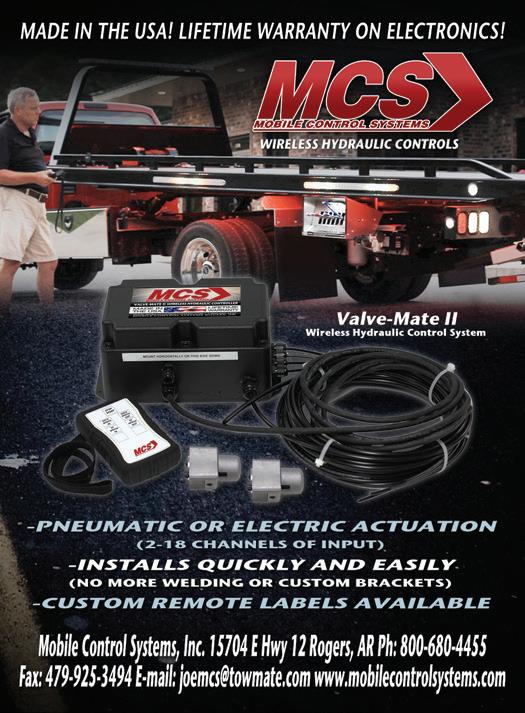

By Jim Figueira

Anew business opportunity presented itself over four years ago when a tower opened an email in his spam folder. While he normally is very cautious when opening a file in spam, for some reason, it just spoke to him. He picked up the phone and dialed the number in the email.
This is a story about a tower who planned his work and worked his plan. His name is George Garbis. His companies are Classic Towing and Green Tech Spill Response Plainfield, IL. After George made that initial phone call, he started a process that would grow his business in areas he never before anticipated. George looked at the opportunity and discussed his
challenges with people at Environmental Cleaning Solutions (ECS, an environmental firm that manufactures cleanup chemicals and administers support programs to the towing industry).
George’s apprehensions were very real. What about the limitations the tow service agreement put on his business? What about getting paid by the insurers? How much do I need and what will it cost? What about waste disposal?
Again, there were many conversations, presentations, and countless hours of study on his part as he slowly moved out of his comfort zone and into a new venture. His preparation included reviewing the support materials provided by ECS and analysis of local regulations, and only then did George take the first step and begin assembling his response plan.
In 2019, George was concerned about his contract with the local police departments on what he could charge for spill cleanup. He started defining and building his spill
response ability. It took a couple of years to move forward as the pandemic put most everything on hold, and in 2021, George implemented his first spill cleanup, a 50-gallon release of diesel.
George already had various types of absorbents, but looked at TC (Traffic Collision) spill cleanup technology to enhance his ability to work effectively in conjunction with both the federal and state environmental objectives in reducing stormwater pollution. Along with the Gold Crew TC (an EPA NCP listed surface-washing agent), George built up his response capability with absorbent mop heads, sock booms, oil-only absorbent pads, duck ponds, a power washer, and a dedicated response vehicle.
While the initial response was not a large spill, the learning curve had begun. Eventually he added a spill response trailer, midi-excavator, a skid steer with a street sweeper attachment, and handheld power brooms to his equipment arsenal.
According to George, and as is the case with most new ventures, attention should be given to how the costs are spent and how long it
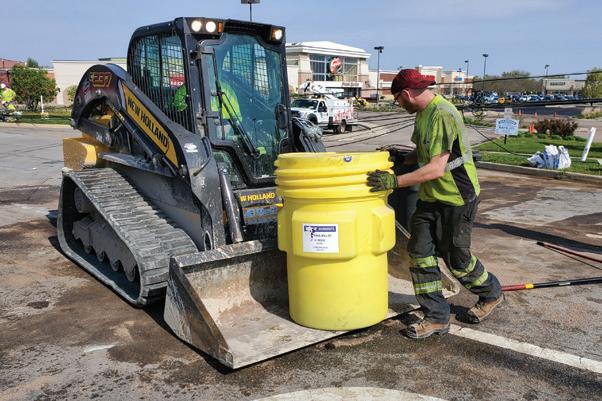
takes to recover the fees from the insurer. There is a bit of anxiety involved in this process. One of the biggest worries George encountered was a $9,000 disposal bill that he paid to Safety Kleen. He had to wait almost a year for the insurer to pay that expense. The disposal costs were high, but with support from ECS, George was able to understand (through lab testing) that disposal regulations qualified much of his disposal material for ADC (Alternative Daily Cover) at the local landfill.
By starting small and building his knowledge, George expanded his company’s ability to respond to and effectively clean up spills that impact waterways. In June of 2022, Green Tech Spill Response was cleaning up a fuel spill on the highway where the fuel entered a storm drain and impacted a small body of water. While, he felt capable of cleaning up the release on the roadway, he was not comfortable addressing the fuels that impacted the water.

In this situation, George learned a hard lesson and received an invaluable education. His mistake was that he called a HAZMAT responder to clean up the impact to the waterway. The issue was that the HAZMAT responder became a subcontractor to GreenTech, and as
such, George was responsible for their bill, regardless of whether or not the insurer paid him.. (Having the state patrol or police call for HAZMAT is the much preferred alternative)
This education ended up paying huge dividends though. After the HAZMAT company arrived, George stayed and observed their cleanup process. He watched how they laid the booms and how they used oil-only white absorbent pads to pick up the rainbows off the surface of the fuel. He watched and learned and thought to himself, “Heck, I could do that!”
George used this opportunity as a learning experience. In this case, the insurer paid GreenTech, so the subcontractor billing was not an issue. More important, in less than a year, George applied what he had learned from the subcontractor to a much larger release and was awarded handsomely for his cleanup activities.
Every cleanup is a challenge. Every release presents different challenges. In winter, the cold presents a different layer of challenges for the cleanup of fuels. Waterways with icy conditions present a particularly difficult challenge as the ice reduces the oleophilic (an affinity for oils and not for water) properties of absorbents. This is when support from Third Parties, such as ECS,

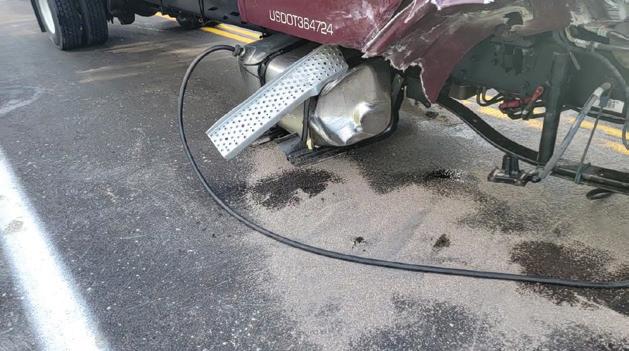
can be helpful.
In some cases, a simple leaf blower will help move the oils floating on the water’s surface to a collection point where the contamination can be removed. It is recommended to never spray a chemical on the waterway or on the shoreline unless prior permission is received from the OSC (On-Scene Coordinator) authorized to use a chemical countermeasure. Typically, dispersing a spill on an inland waterway is not an approved response action.
In addition, cleaning up a burnt vehicle isn’t just about removing the charred remains and often presents an enormous challenge. Where the fluids are not the primary challenge, the soot and debris are. Such an encounter was enhanced when a motorcycle crashed into the wheels of a big rig, igniting a fire and melting the tires onto the roadway. This posed s a huge challenge as once the “rubber” from the impacted area gets wet, the surface becomes exceptionally slick.
Overcoming this difficulty in cleaning up the area was made straightforward with a little ingenuity by GreenTech. Once the vehicles had been removed, GreenTech applied Gold Crew TC to help release the heavy rubber that had melted onto the roadway. A clay-based oil absorbent was then worked into the impacted roadway using the bucket of a skid steer. This absorbent material acted as an abrasive sandpaper which helped to
peel the rubber off the roadway for collection and disposal. The job took several hours and was billed out and quickly paid.
Over the years, GreenTech learned from its mistakes, received an education through both research and experience, and built knowledge and confidence that culminated with EPA recognition of their services.
One incident involved a tractortrailer that crashed over a curb and released diesel fuel onto asphalt, in soil, and found its way into a storm drain where the outcropping dropped into a series of ponds that discharged into the Kankakee River in Illinois. It was initially reported as a 10-gallon release, when in fact, it was closer to 75 gallons or more.
GreenTech responded and cleaned up the release to the asphalt, excavated the impacted soil, and traced the runoff to the storm drain.
From lessons learned, GreenTech followed the storm drain to determine where the receiving water was located.
Again, from their “education” from watching the HAZMAT team years earlier, GreenTech set a series of booms to contain the impacted area on the pond and proceeded to clean up the storm drain. As many of the
activities were conducted at night, which made it difficult to fully assess, GreenTech contacted ECS to discuss the procedures required to clean up the release.
Two days later, an EPA official contacted GreenTech regarding this spill and informed them that an inspection of the spill site would take place. As this was GreenTech’s first spill involving the EPA, they were understandably nervous. Upon contacting ECS, the EPA determined the boom placement and cleanup procedures were reviewed and subsequently concluded that the steps taken were “textbook correct.”
A couple of days later, the EPA official returned to the cleanup scene and was impressed at the efficient and complete cleanup activities employed by GreenTech. The EPA official asked if GreenTech was on the state’s spill response list, but Greentech’s response capabilities were limited to vehicle operating
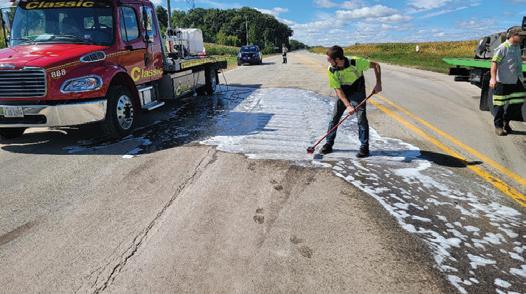
fluid (VOFs), and they are not a complete HAZMAT responder. Even though GreenTech was not qualified to make the EPAs response list, the EPA official requested their information for possible clean-up assistance in the future where VOFs were the issue.
GreenTech kept in touch with the insurer step-by-step to make

sure there was involvement by the responsible party’s insurance company. Having well documented the multi-month cleanup of the release, with pictures, communications with the EPA, and a 66-page narrative, GreenTech was quickly paid the $170,000 billing.
Over the years, GreenTech moved slowly but methodically to encompass the spill cleanup of vehicle operating fluids (VOFs). Since those early learning-curve
days, GreenTech has built and established themselves as a cleanup contractor that responds to a wide variety of fuel-related releases. There have been numerous jobs unrelated to vehicle collisions where GreenTech was called in to cleanup petrochemical releases. A simple phone call started Classic Towing on a growth path that now incorporates a highly profitable environmental cleanup division.
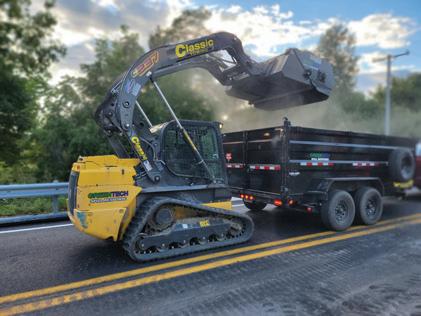


By Steve Temple


The Spiderman graphic on Carl Thompson’s double-decker car carrier is an apt theme. He’s had to be pretty agile in his 34-plus years as a towman. He started out working in a junkyard, operating a crusher, and decided that transporting wrecked cars was his true calling.
“Nobody ever taught me how to operate a four-car carrier,” he admits. “I just had to figure it out.”
While most of his work for The Body Works Towing involves simply transporting wrecked vehicles for insurance companies, he’s encountered some unusual situations that required employing his “Spidey Sense.”
Upon arriving on one call to pick up a car, he found it hanging precariously out of the second-story level of a parking garage. Instead of
calling for a rotator to recover it, he simply snatch-blocked it and then winched the dangling car directly onto to his 30-foot Century carrier’s rooftop bed. This particular wrecker runs a 2023 Freightliner built by Zip’s and provided by East Coast Truck & Trailer.
Another time he was asked to transport a 24-foot boat, which he assumed would be on a trailer. Turns out it was half-sunk in the water, so he and a friend first had to swim out to bail water out of the partially submerged hull. Then Carl winched the boat to the shore and loaded it on the deck, using lots of cargo straps and cribbing around the keel to keep it from tipping over.
One of Carl’s towing experiences was a life-threatening near miss.
“I jumped under the bed of my truck to avoid being hit by a dump


truck’s driver not paying attention,” he recalls. “A car had blown a tire and I was trying to change it on the Interstate shoulder, as I was between exits and not wanting debris flying around to cause a wreck or damage to other cars.”
He called the VDOT out after that, and they pulled a highway safety truck behind him to serve as an added barrier.
Given that incident and all the other hazardous situations he’s encountered over the years, Carl wrote a sad, somber poem that expresses his concern for fellow towers and the risks they face every day:
“The call came in, “I’ll be right there.”
A kiss on her cheek, a stroke of her hair.
“Daddy will be back soon, I’m needed on scene.
I love you good night, I hope you have sweet dreams.”
Arriving on scene, strobes flash in the night.
The towman is here, it’s going to be all right.
I never saw him coming as I reached for my chain.
All I heard was the squealing and I felt no pain.
He looked down for a second to answer a text.
Too late on the brakes for what happened next.
Fighting back tears and feeling alone, my wife sobs to my daughter, “Daddy can’t come back home.”
The last gift she receives as I left this life, is a folded black flag with a thin yellow stripe.
Had I known when I left, I’d had held them both closer.
Please save the next one Slow Down and Move Over!
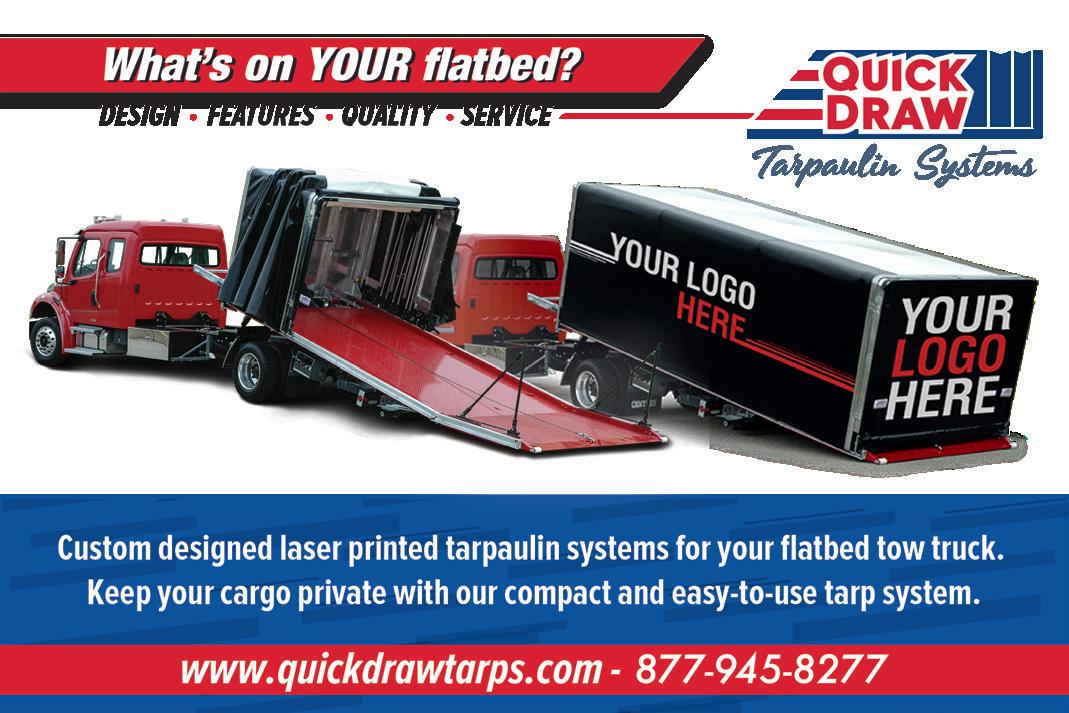






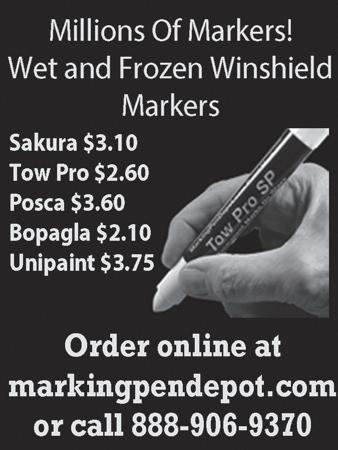



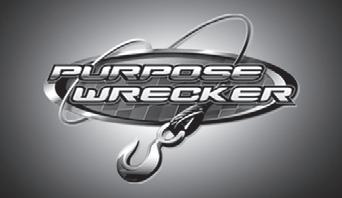









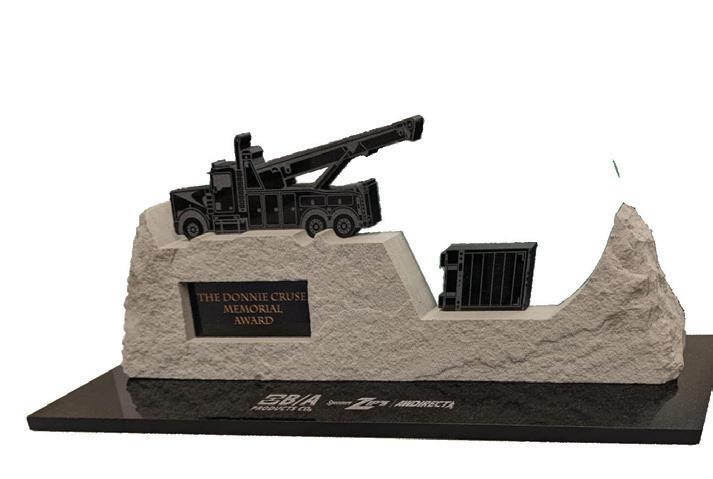

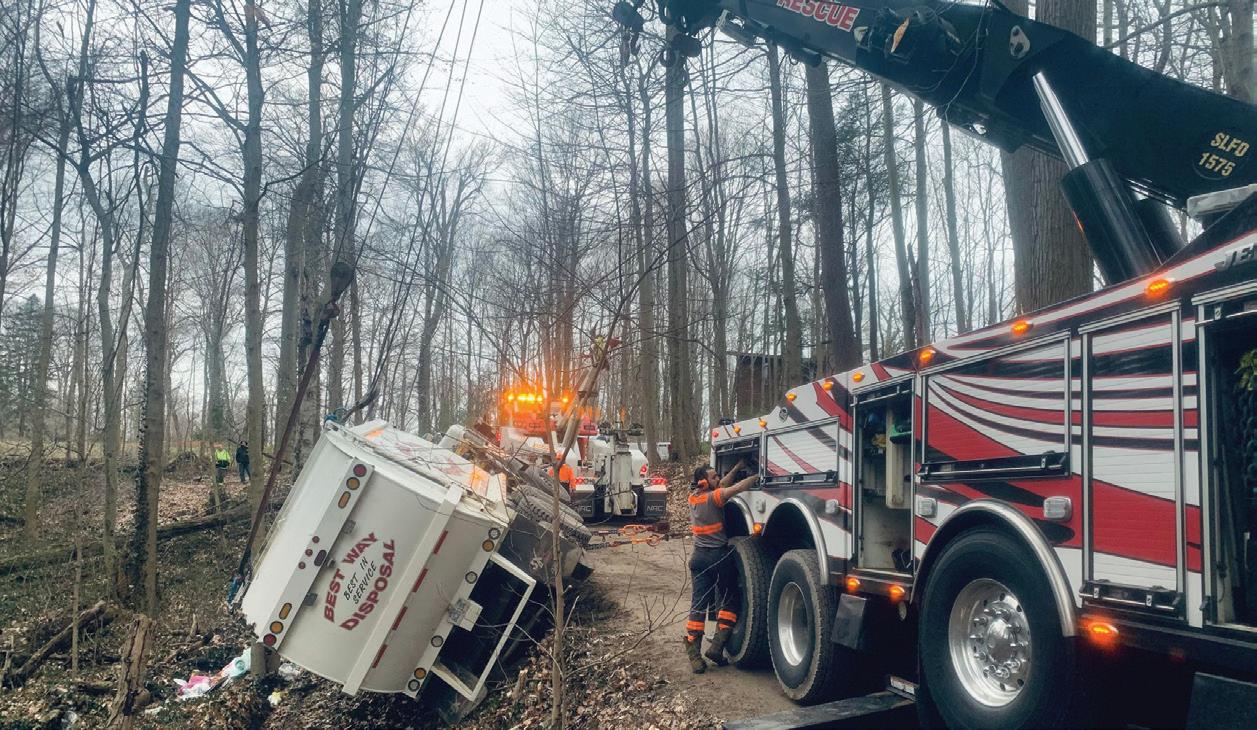

By George L. Nitti

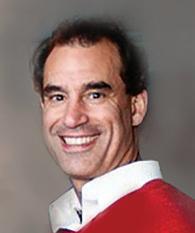
You’ve heard of the Liberty Bell and Liberty Ships, but how about a Liberty Rotator? Well, check out this 2018 Peterbilt 389/1150 Century rotator at Liberty Towing Service, LLC. Located in Madison, Wisconsin, the company recently picked up this wrecker from ZIPs Truck Equipment and gave it a patriotic wrap.
“It was time for a new rotator,” notes owner Rod Timmerman, who founded Liberty in 2009. “Our last one was 20 years old.” Well, it isn’t exactly new, as it had 162,000 miles on it, but represented a huge savings for him.
“I’m spending $300,000 dollars less and the technology from 2018 to present has not changed a lot,” he points out. “So, I can essentially do the same thing as what a brand new one can do. I’ve got proportional remotes; I’ve got five winches; the only thing I don’t have is a knee boom.”
This rotator’s graphics were inspired by Timmerman’s previous wrecker, which honored all branches of the military. To recreate a design on the same theme, he worked with local graphics company, Madison Wraps of Sun Prairie, Wisconsin. His response to the armedforces visuals? “Adam and his crew knocked it out of the park.”
The stellar wrap in part pays homage to both his father and grandfather, whose images appear on each side of the cab. “My father was in Vietnam and my grandfather was in World War II,” Timmerman explains. On both sides of the unit, all branches of the military come into focus, permeated with dramatic scenes signifying American strength and power.
On the passenger side, at the nose area, several soldiers are stationed in combat formation as the sun peers through the clouds, illuminating their heroic figures. As the American flag design unfolds on the door, it’s followed by the image of Timmerman’s grandfather, Walter, dressed in formal military garb.

Adorning the passenger side of the wrecker section is a jet in ascent and a tank taking aim, as the Liberty name punctuates both images.
“They overlaid Liberty atop the wrap with reflective lettering,” adds Timmerman. “They cut Liberty by hand around the images on the wrap. It was amazing the way they laid this thing out. I could easily take the Liberty name off and resell it as it is.”
Further back is a helicopter, a squad of paratroopers descending to the ground, snipers nestled in the woods, drones in the air, and mossy areas that look like Vietnam portraying other military imagery.
On the driver’s side, up front
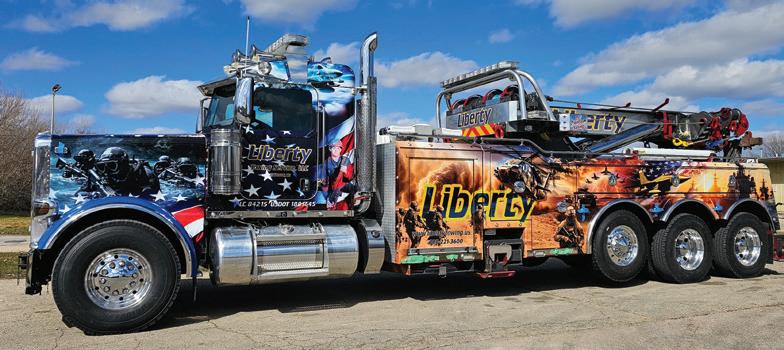

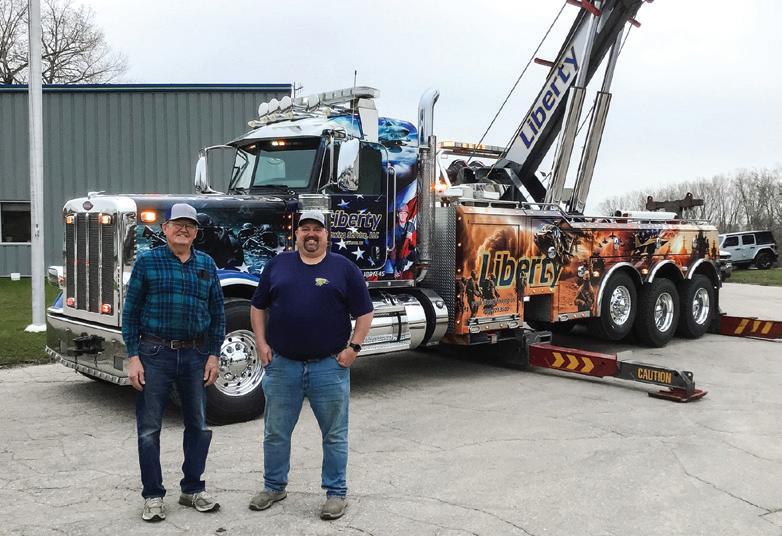
several Navy Seals are depicted in action, heavily armed and wading through water. On the cab is an image of Timmerman’s father, Ron, holding his weapon. Then there’s also a scene from Desert Storm shown, with soldiers on the ground and the formation of a big sand cloud, followed by a helicopter, Humvees, and jets in formation accented with bolts of lightning, followed by a fleet of battleships.
Compositionally, this wrap flows, enhanced by a myriad of colors including red, white and blue. An American Eagle is spread across the hood, its sharp talons conveying ferocity.
There are many other impactful touches as well.
At the back end of the rotator is a black ribbon signifying “Slow Down, Move Over. Support Towing Operators. A slogan reads: “Proud to be an American.” The spreader bars, encased in white tubes, are wrapped like missiles. At the back, a message reveals: “Past and Present. Thank you for your service.” Then there is another slogan that is a play on “Let Freedom Ring. “Since it’s a rotator and the boom goes around, I said, let’s change it to ‘Let Freedom Swing,’” Timmerman explains.
This rotator might look familiar, as it was originally showcased at the American Towman Exposition in Baltimore in 2018, and later featured in a recovery story in American Towman Magazine in December of 2023, where it rescued a concrete mixer that busted through a wooden bridge.
“That company traded the rotator to ZIP’s and bought a brand new one,” said Timmerman. But he gave this proven wrecker a new life in a tribute to American military heroes.
Chassis: 2018 Peterbilt 389
Wrecker: Century 1150 Rotator with proportional winches
Custom features: SDU4 Wheel lifts, Will-Burt Light Tower
Graphics: Madison Wraps of Sun Prairie, Wisconsin
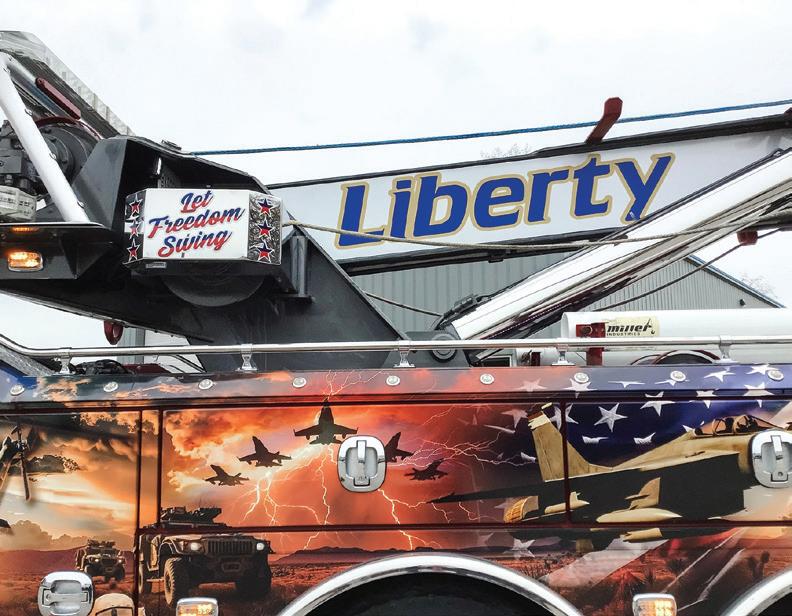
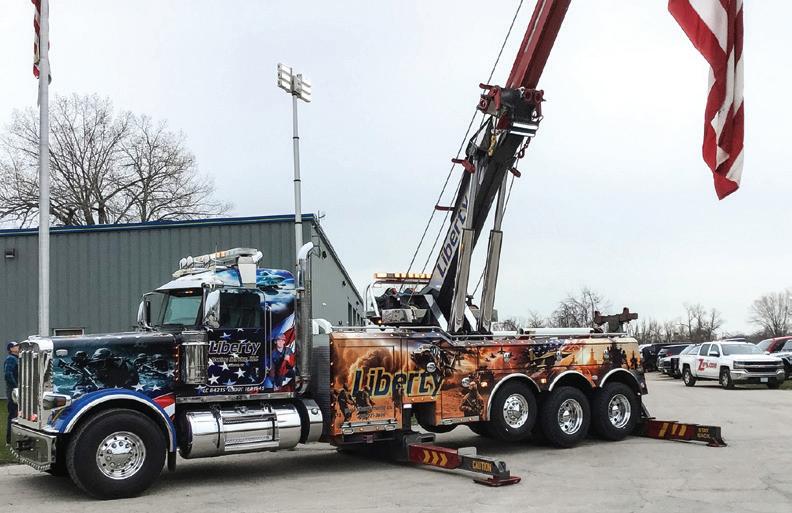
Do you know a tower who risked their life to save another while on the job?
PLEASE INCLUDE:
• Nominee’s name and company
• Nominee’s city and state • Nominee’s phone number
• Your name • Your phone number
• Your mail/email address • Detailed account of incident

Send nominations via mail to: Bryna Stankiewicz, American Towman 2 Overlook Drive, Suite 5, Warwick, NY 10990 Or email: bryna@towman.com

Note: Describe the incident and include the name, company, phone number and address of the nominee. All accounts should be able to be corroborated by a third party source, i.e. police, victim, witness.

Steve Calitri Editor-in-Chief scalitri@towman.com
By Steve Calitri
There are lessons and guidance to be had from all religions. All beliefs resort to daily prayer to keep one on the right path in life. In the Islamic faith, the Koran calls for prayer five times a day. Raised a Christian, I grew up saying my prayers each night in bed, a practice I’ve always kept. A God-fearing person will say prayers throughout the day, or at least call on God’s mercy and grace for his presence in all things, even call on the highest command for a brief moment.
Fellowship, recognizing good and evil, making sense out of this world, pulling together as a family; for all of this we call on the help of a higher power. Non-believers may call upon their best natures and intelligence, and some kind of innate strength.
Those of us who run a business have good reason to ask for guidance. It may come from one’s spouse, or one’s friend. It can also come from God, if you believe. I will make an educated guess and say such guidance is rarely sought from a competitor.
One should respect one’s competitors, even in the towing business. You know what your competitor goes through in the course of a day with employees, incidents, and critical relationships. Indeed, you could probably learn from your competitor.
But should you trust him?
There is no question in my mind that competitors can co-exist in a positive manner. I will also say, go ahead and love thy competitor. He may be an adversary, but he or
she may also be one of the good guys who can be a friend to your business. Am I naïve to think so?
After observing this cut-throat industry for over five decades?
I know what it takes to be a competitor and win. We should respect the competitor, but more so, we should talk and discover areas where cooperation makes sense. This doesn’t mean that one should put all his trust into his adversary’s hands. In many verse, the bible warns about trusting your fellow man.
So, what happens on a multi-car pileup where several tow companies have been called to the scene. How does trust play a role where towers must work together? There must be an element of trust.
Can dispatching responsibilities be shared amongst several companies? Talk to your competitors and find out it’s feasible.
Don’t necessarily give away any trade secrets, but trust in your fellow man enough to talk with him, your competitor. Somewhere down the line he may do you and your business a favor.
As for God, don’t wait until the next time you visit a house of worship to call on him. You have things to do, you’re always on the go. Certainly, you don’t wait for a splendid feast every time you need to replenish your belly. Just as you can do take-out at your local restaurant, you can get God-to-Go when you’re rushing out the door to get to a highway incident –one that may put your life at risk. He’s ready when you are.


The Biden administration has tightened fuel economy standards for cars and SUVs, with the National Highway Traffic Safety Administration (NHTSA) issuing rules aimed at boosting the average efficiency of new vehicles to over 50 miles per gallon by 2031. These standards, starting with 2027 models, are projected to save 70 bil-
lion gallons of gasoline by 2050 and reduce fuel costs by about $600 over a vehicle's lifespan. The final rules are less stringent than initially proposed, after automakers objected.
Transportation Secretary Pete Buttigieg highlighted the financial and environmental benefits, while responses from environmental advocates varied, with some praising the progress and others wanting even more stringent measures. The auto industry expressed concerns about overlapping regulations but acknowledged collaborative efforts among agencies.
The administration is also promoting electric vehicle adoption through tax credits and public charging investments, though sales growth has recently slowed. Opposition from Republicans, including Donald Trump, who has vowed to repeal Biden's climate regulations, poses a challenge to these efforts.
Source: washingtonpost.com

Kerry Coates Kavanaugh was sentenced to 15 years in prison for striking and killing a tower and then leaving the scene of the incident.
Kavanaugh was driving a pickup truck that killed tow truck driver Patrick Morin, who was parked off the roadway, towing a vehicle outside of Goldthwaite, Texas at the time of the incident.

After the crash, Kavanaugh and a passenger fled the scene and went to a house outside of Lometa. Kavanaugh surrendered himself a day after his passenger contacted the investigators.
The 35th Judicial District Attorney’s Office oversaw the case and sentenced Kavanaugh to 15 years. Cara Landers, Assistant District Attorney, released this statement:
“We are so honored to have advocated for justice for the family of Patrick Morin, and we hope that a sentence of this magnitude, despite a lack of criminal history on the part of Mr. Kavanaugh, can bring some comfort to the many lives that Mr. Morin touched. We are proud to live in a community surrounded by law enforcement that thoroughly investigates crimes and allows us to pursue justice and we continually encourage those who drive on Texas roads to respect and honor the work of our first responders by following the law.”
Source: bigcountryhomepage.com
Miller Industries and Marietta Wrecker Service teamed up to donate $10,000 to the Survivor's Fund, which helps provide funding to the surviving families of tow operators that have fallen in the line of duty.
Miller Industries Towing Equip-


ment Inc. announced the winner of the Survivor Fund Golf Classic “Closest to Pin” contest prize. This year’s winner was Josh Bequette from US Fleet Tracking. What is special about this year’s prize is that Miller Industries and Marietta Wrecker Service each donated $5,000 to the Survivor Fund in the winner’s (Mr. Bequette’s) name.
Miller Industries has always been a large supporter of the Survivor Fund and the annual Golf Classic, which is held in Orlando, Florida. When Steve Welchel of Marietta Wrecker Service in Marietta, GA heard about this he knew they could help even more.
“We wanted to help, so I asked Miller Industries if we could match their donation and help provide greater funding for the families of those lost in tragedy to the towing and recovery industry. The money raised goes a long way to help families cover unforeseen costs as they deal with their loss,” said Steve Welchel.
Source: Press Release Miller Industry
Minnesota lawmakers overwhelmingly voted in favor of eliminating towing vehicles with unpaid parking tickets. Under previous state law, towing authorities could only tow vehicles from expired parking meters if the vehicle had five or more unpaid parking tickets.
The statute still allows vehicles to be towed for violating snow emergency regulations, blocking driveways or fire hydrants, and parking in otherwise restricted areas. But eliminating collecting debt from parking tickets as a basis for towing a vehicle aims to prevent burdening people by imposing even more debt in the form of impound fees to retrieve their vehicles said Rep. Erin Koegel, who authored the legislation.
“When parking tickets result in the loss of a vehicle, it has immediate and negative economic outcomes that can
result in job loss, and disruptions to childcare and education,” she said. “So many people in Minnesota use cars to commute to work, and 30% of households in Minnesota only have one vehicle, so how could we expect people to pay back their fines when we’re taking away their way to work.”
Jenny Catchings, state policy manager for Justice Action Network, said it can cost a vehicle owner around $640 to retrieve their vehicle from an impound lot, which includes the previous parking debt and new fees incurred by the tow. In addition to how costly towing for debt collection is for lower-income residents, Catchings said the practice is ineffective as well. Catchings pointed to an audit conducted by the city of San Diego that found the city was losing about $1.5 million towing vehicles and housing them at impound lots, and 27% of vehicles were never recovered.








The Biden administration has tightened fuel economy standards for cars and SUVs, with the National Highway Traffic Safety Administration (NHTSA) issuing rules aimed at boosting the average efficiency of new vehicles to over 50 miles per gallon by 2031. These standards, starting with 2027 models, are projected to save 70 billion gallons of gasoline by 2050 and reduce fuel costs by about $600 over a vehicle’s lifespan. The final rules are less stringent than initially proposed, after automakers objected.
Transportation Secretary Pete Buttigieg highlighted the financial and environmental benefits, while responses from environmental advocates varied, with some praising the progress and others wanting even more stringent measures. The auto industry expressed concerns about overlapping regulations but acknowledged collaborative efforts among agencies.
The administration is also promoting electric vehicle adoption through tax credits and public charging investments, though sales growth has recently slowed. Opposition from Republicans, including Donald Trump, who has vowed to repeal Biden’s climate regulations, poses a challenge to these efforts.
Source: washingtonpost.com
Kerry Coates Kavanaugh was
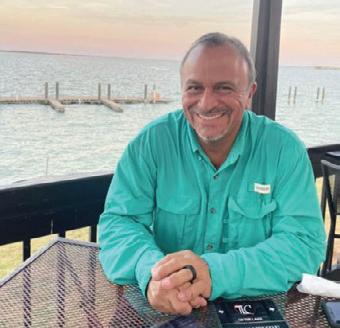
sentenced to 15 years in prison for striking and killing a tower and then leaving the scene of the incident.
Kavanaugh was driving a pickup truck that killed tow truck driver Patrick Morin, who was parked off the roadway, towing a vehicle outside of Goldthwaite, Texas at the time of the incident. After the crash, Kavanaugh and a passenger fled the scene and went to a house outside of Lometa. Kavanaugh surrendered himself a day after his passenger contacted the investigators.
The 35th Judicial District Attorney’s Office oversaw the case and sentenced Kavanaugh to 15 years.
Cara Landers, Assistant District Attorney, released this statement:
“We are so honored to have advocated for justice for the family of Patrick Morin, and we hope that a sentence of this magnitude, despite a lack of criminal history on the part of Mr. Kavanaugh, can bring some comfort to the many lives that Mr. Morin touched. We are proud to live in a community surrounded by law enforcement that thoroughly investigates crimes and allows us to pursue justice and we continually encourage those who drive on Texas roads to respect and honor the work of our first responders by following the law.”
Source: bigcountryhomepage.com
Miller Industries and Marietta Wrecker Service teamed up to donate $10,000 to the Survivor’s Fund, which helps provide funding to the surviving families of tow operators that have fallen in the line of duty.
Miller Industries Towing Equipment Inc. announced the winner of the Survivor Fund Golf Classic “Closest to Pin” contest prize. This year’s winner was Josh Bequette from US Fleet Tracking. What is

special about this year’s prize is that Miller Industries and Marietta Wrecker Service each donated $5,000 to the Survivor Fund in the winner’s (Mr. Bequette’s) name.
Miller Industries has always been a large supporter of the Survivor Fund and the annual Golf Classic, which is held in Orlando, Florida. When Steve Welchel of Marietta Wrecker Service in Marietta, GA heard about this he knew they could help even more.
“We wanted to help, so I asked Miller Industries if we could match their donation and help provide greater funding for the families of those lost in tragedy to the towing and recovery industry. The money raised goes a long way to help families cover unforeseen costs as they deal with their loss,” said Steve Welchel.
Source: Press Release Miller Industry
Minnesota lawmakers overwhelmingly voted in favor of eliminating towing vehicles with unpaid parking tickets. Under previous state law, towing authorities could only tow vehicles from expired parking meters if the vehicle had five or more unpaid parking tickets.
The statute still allows vehicles to be towed for violating snow emergency regulations, blocking driveways or fire hydrants, and parking in otherwise restricted areas. But eliminating collecting debt from parking tickets as a basis for towing a vehicle aims to prevent burdening people by imposing even more debt in the form of impound fees to retrieve their vehicles said Rep. Erin Koegel, who authored the legislation.
“When parking tickets result in the loss of a vehicle, it has immediate and negative economic outcomes that can result in job loss, and disruptions to childcare and education,” she said. “So many people in Minnesota use cars to commute to work, and 30% of households in Minnesota only have one vehicle, so how could we expect people to pay back their fines when we’re taking away their way to work.”
Jenny Catchings, state policy manager for Justice Action Network, said it can cost a vehicle owner around $640 to retrieve their vehicle from an impound lot, which includes the previous parking debt and new fees incurred by the tow. In addition to how costly towing for debt collection is for lower-income residents, Catchings said the practice is ineffective as well. Catchings pointed to an audit conducted by the city of San Diego that found the city was losing about $1.5 million towing vehicles and housing them at impound lots, and 27% of vehicles were never recovered.
The family of Corey Iodice, a Connecticut tower who was struck and killed in 2020, will receive a $1.5 million settlement from the man responsible for his death.
Dean Robert is currently in prison after pleading guilty in Superior Court to second-degree manslaughter, reckless driving, driving under the influence, and failure to move over for an emergency worker, for the April 22, 2020, death of 58-year-old Iodice.
Robert is currently incarcerated with a maximum release date of Sept. 1, 2026, according to the state De-
partment of Corrections.
Iodice, an employee of Iodice Family Transport in Fairfield, was in the process of loading a disabled Mercedes Benz onto the flatbed of his tow truck on the southbound side shoulder of the Merritt Parkway. He was struck by a BMW sedan driven at more than 90 miles an hour by Robert, according to police.
Source: nhregister.com
In May, led by the American Recovery Association (ARA) and lobbyist Van Scoyoc Associates, representatives from the industry, met with Members of Congress, staffers and the Consumer Financial Protection Bureau to discuss issues the recovery industry is facing.
The discussions centered around lender indemnification, the consolidation of power in the auto finance industry, and the roles brokers and forwarders play in the industry. Specifically, how agents aren’t paid unless they repossess a vehicle, and how this is to the detriment to the repossession industry.
This is the first time representatives of the recovery industry have met with Congress in person to bring attention to these issues that concern repo agents. In attendance were
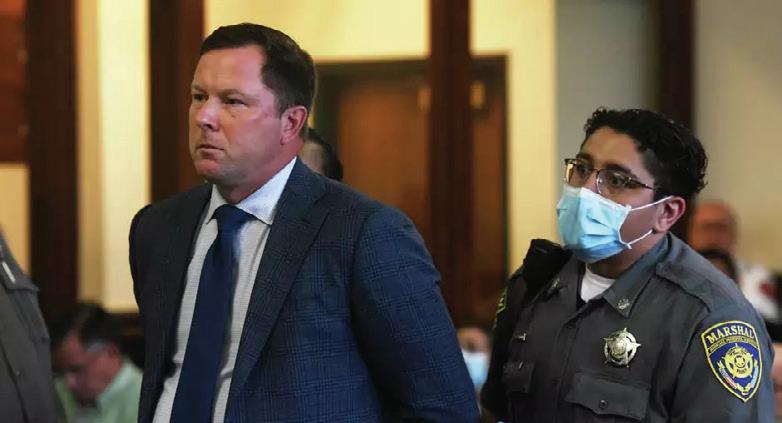
ARA President Vaughn Clemmons and Immediate Past President Dave Kennedy, ARA Vice President and CALR President Marcelle Egley, Texas ARP President Stephanie Findley, Harding Brooks Insurance Vice President Mike Peplinski, and Recovery Agency Owner and ARA member Richard Grosvenor.
Source: curepossession.com
Procession for Illinois Tower
Illinois towman Gregory W Hostetler, who was shot and killed over what police said was a $50 tow, was honored with two processions as family, friends, coworkers, and fellow tow truck drivers gathered for a memorial procession in their trucks. Hostetler’s nephew, Wyatt Wages was among them.

“I just want to thank J&K Towing, TMG Towing, Owens, Precision, Lugari, Richard’s, and Shaners for showing us amazing support,” Wages said on Facebook. “Greg would have loved this.”
Hostetler was the owner of Greg’s Towing and Recovery, Inc and Five Star Auto Sales. He was born in
Decatur, Illinois.
According to his obituary, “Greg loved being in the scrap business and junking. He was a collector of old oil cans and had one of the best-known oil can collections in the country. His true passion was collecting antique toys, a hobby that he shared along with his dad during his lifetime. Greg also enjoyed old cars. While enjoying his hobbies, Greg made many true lifetime friends all over the country. Greg was described as a friend who would have done anything for anyone, with lots of true friends and a heart of gold.”
Source: wcia.com curepossession.com









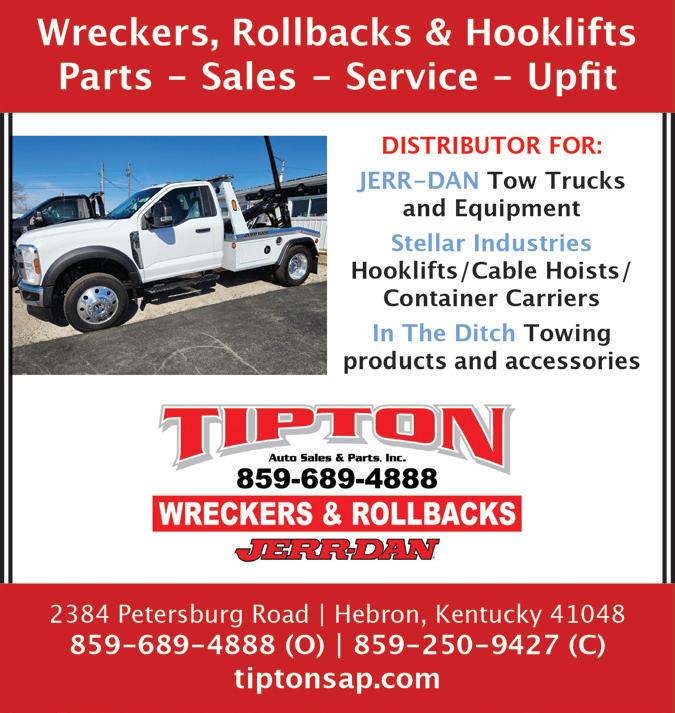

The Biden administration has tightened fuel economy standards for cars and SUVs, with the National Highway Traffic Safety Administration (NHTSA) issuing rules aimed at boosting the average efficiency of new vehicles to over 50 miles per gallon by 2031. These standards, starting with 2027 models, are projected to save 70 billion gallons of gasoline by 2050 and reduce fuel costs by about $600 over a vehicle’s lifespan. The final rules are less stringent than initially proposed, after automakers objected.
Transportation Secretary Pete Buttigieg highlighted the financial and environmental benefits, while responses from environmental advocates varied, with some praising the progress and others wanting even more stringent measures. The auto industry expressed concerns about overlapping regulations but acknowledged collaborative efforts among agencies.
The administration is also promoting electric vehicle adoption through tax credits and public charging investments, though sales growth has recently slowed. Opposition from Republicans, including Donald Trump, who has vowed to repeal Biden’s climate regulations, poses a challenge to these efforts.
Source: washingtonpost.com
Kerry Coates Kavanaugh was sentenced to 15 years in prison for strik-

ing and killing a tower and then leaving the scene of the incident.
Kavanaugh was driving a pickup truck that killed tow truck driver Patrick Morin, who was parked off the roadway, towing a vehicle outside of Goldthwaite, Texas at the time of the incident. After the crash, Kavanaugh and a passenger fled the scene and went to a house outside of Lometa. Kavanaugh surrendered himself a day after his passenger contacted the investigators.
The 35th Judicial District Attorney’s Office oversaw the case and sentenced Kavanaugh to 15 years. Cara Landers, Assistant District Attorney, released this statement:
“We are so honored to have advocated for justice for the family of Patrick Morin, and we hope that a sentence of this magnitude, despite a lack of criminal history on the part of Mr. Kavanaugh, can bring some comfort to the many lives that Mr. Morin touched. We are proud to live in a community surrounded by law
enforcement that thoroughly investigates crimes and allows us to pursue justice and we continually encourage those who drive on Texas roads to respect and honor the work of our first responders by following the law.”
Source: bigcountryhomepage.com
Miller Industries and Marietta Wrecker Service teamed up to donate $10,000 to the Survivor’s Fund, which helps provide funding to the surviving families of tow operators that have fallen in the line of duty.
Miller Industries Towing Equipment Inc. announced the winner of the Survivor Fund Golf Classic “Closest to Pin” contest prize. This year’s winner was Josh Bequette from US Fleet Tracking. What is special about this year’s prize is that Miller Industries and Marietta Wrecker Service each donated $5,000 to the Survivor Fund in the winner’s (Mr. Bequette’s) name.
Miller Industries has always been a
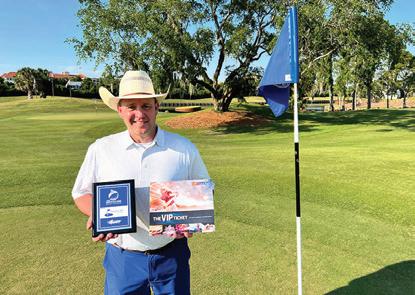
large supporter of the Survivor Fund and the annual Golf Classic, which is held in Orlando, Florida. When Steve Welchel of Marietta Wrecker Service in Marietta, GA heard about this he knew they could help even more.
“We wanted to help, so I asked Miller Industries if we could match their donation and help provide greater funding for the families of those lost in tragedy to the towing and recovery industry. The money raised goes a long way to help families cover unforeseen costs as they deal with their loss,” said Steve Welchel.
Source: Press Release Miller Industry








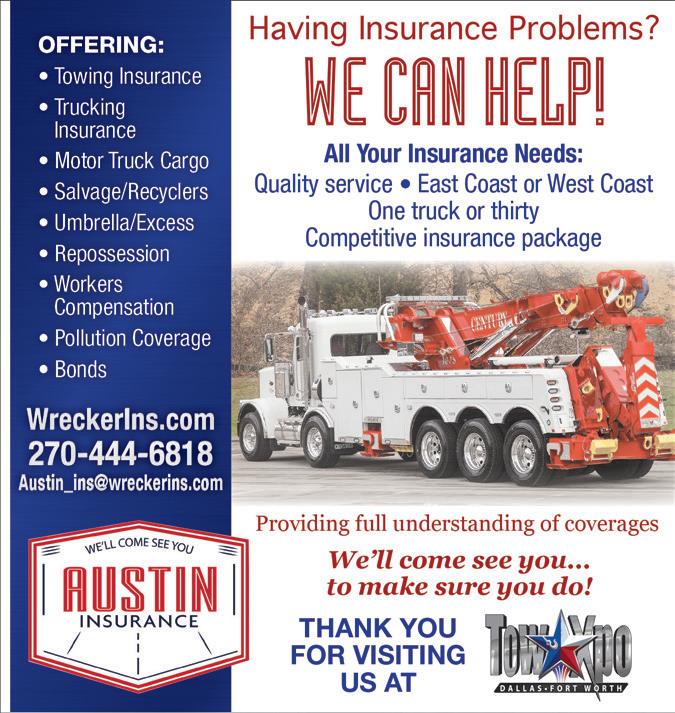

The Biden administration has tightened fuel economy standards for cars and SUVs, with the National Highway Traffic Safety Administration (NHTSA) issuing rules aimed at boosting the average efficiency of new vehicles to over 50 miles per gallon by 2031. These standards, starting with 2027 models, are projected to save 70 billion gallons of gasoline by 2050 and reduce fuel costs by about $600 over a vehicle’s lifespan. The final rules are less stringent than initially proposed, after automakers objected.
Transportation Secretary Pete Buttigieg highlighted the financial and environmental benefits, while responses from environmental advocates varied, with some praising the progress and others wanting even more stringent measures. The auto industry expressed concerns about overlapping regulations but acknowledged collaborative efforts among agencies.
The administration is also promoting electric vehicle adoption through tax credits and public charging investments, though sales growth has recently slowed. Opposition from Republicans, including Donald Trump, who has vowed to repeal Biden’s climate regulations, poses a challenge to these efforts.
Source: washingtonpost.com
Kerry Coates Kavanaugh was sentenced to 15 years in prison for striking and killing a tower and then leaving the scene of the incident.
Kavanaugh was driving a pickup truck that killed tow truck driver Patrick



Morin, who was parked off the roadway, towing a vehicle outside of Goldthwaite, Texas at the time of the incident. After the crash, Kavanaugh and a passenger fled the scene and went to a house outside of Lometa. Kavanaugh surrendered himself a day after his passenger contacted the investigators.
The 35th Judicial District Attorney’s Office oversaw the case and sentenced Kavanaugh to 15 years. Cara Landers, Assistant District Attorney, released this statement:
“We are so honored to have advocated for justice for the family of Patrick Morin, and we hope that a sentence of this magnitude, despite a lack of criminal history on the part of Mr. Kavanaugh, can bring some comfort to the many lives that Mr. Morin touched. We are proud to live in a community surrounded by law enforcement that thoroughly investigates crimes and allows us to pursue justice and we continually encourage those who drive on Texas roads to respect and honor the work of our first responders by following the law.”
Source: bigcountryhomepage.com
